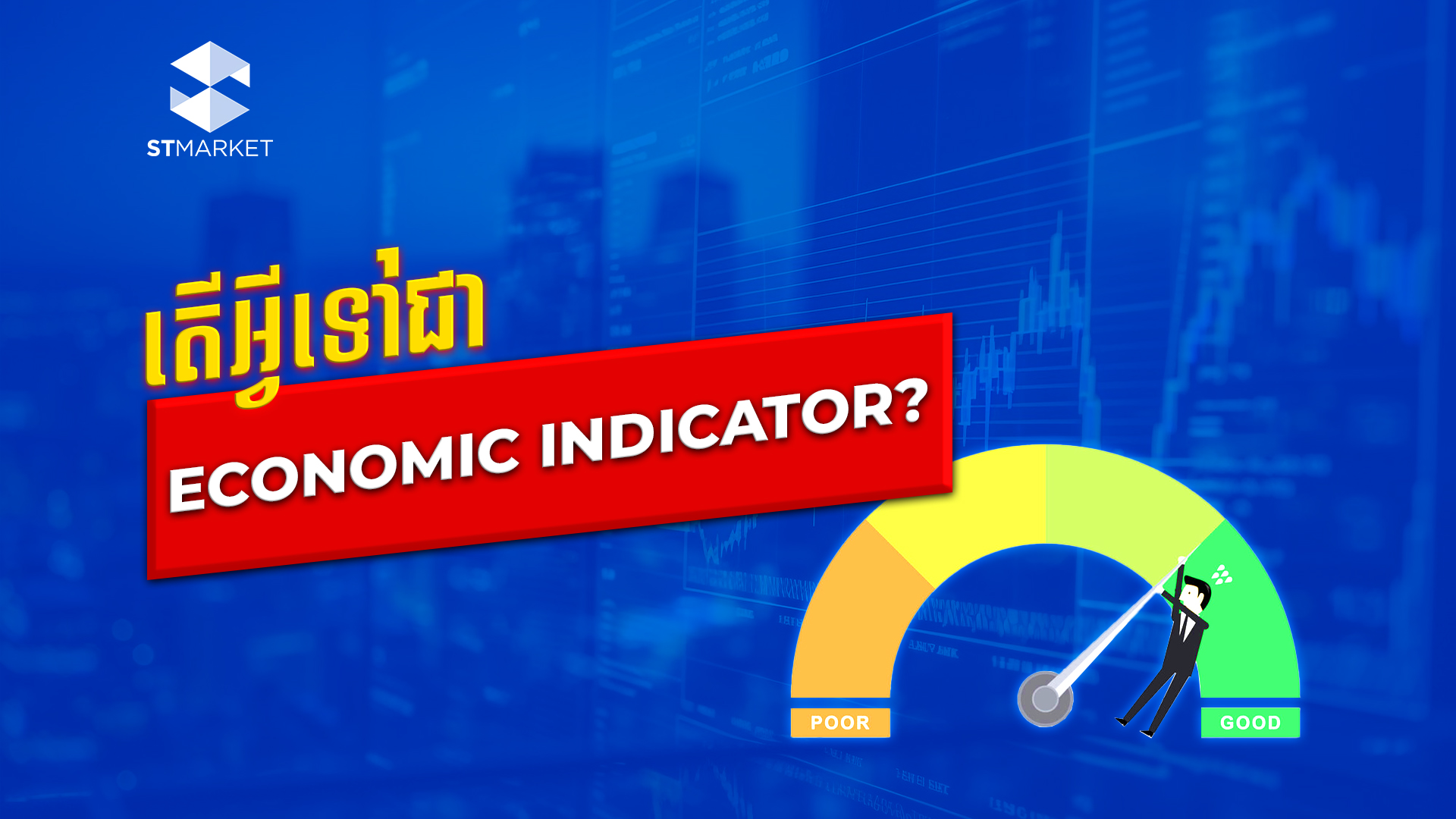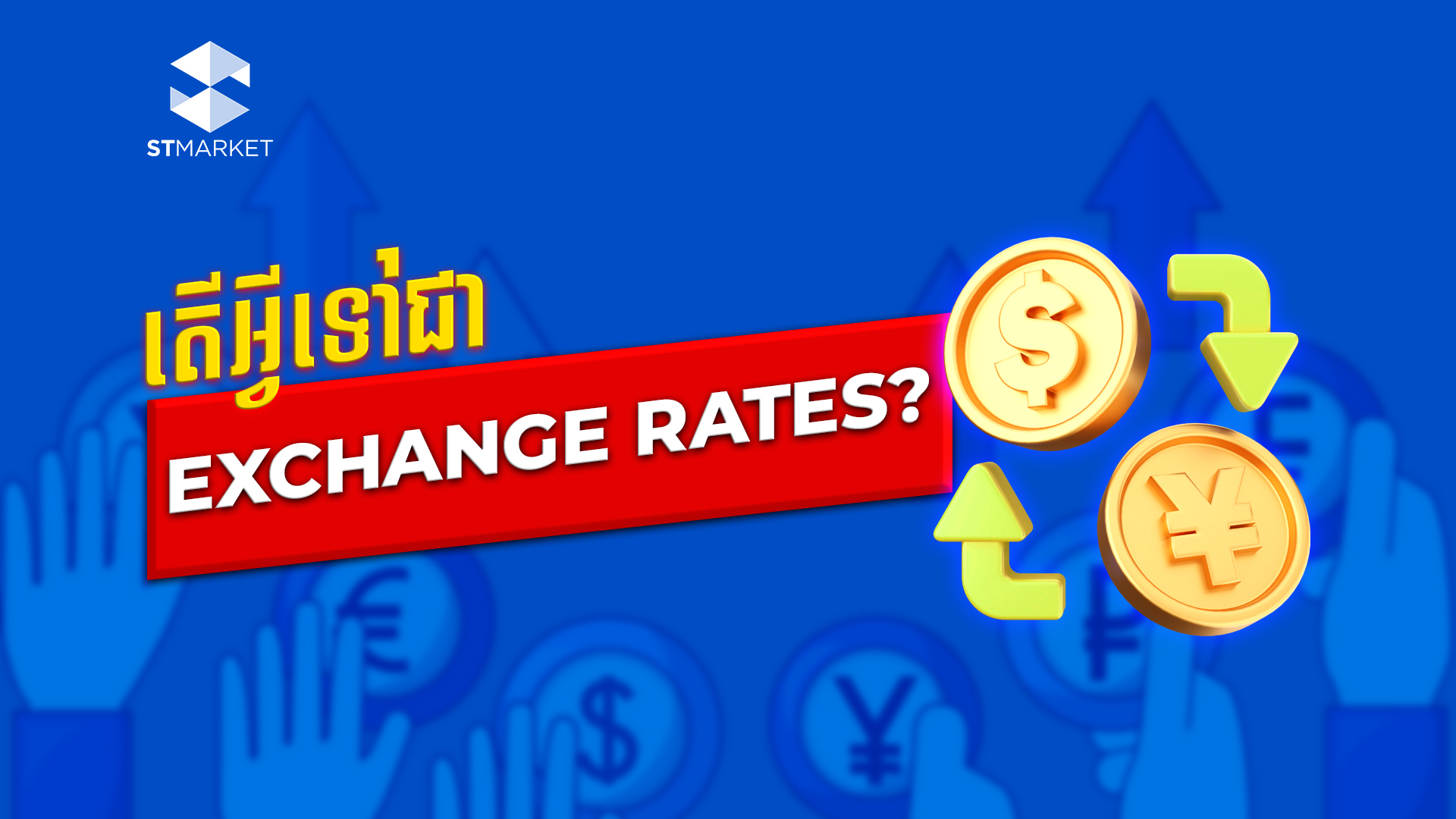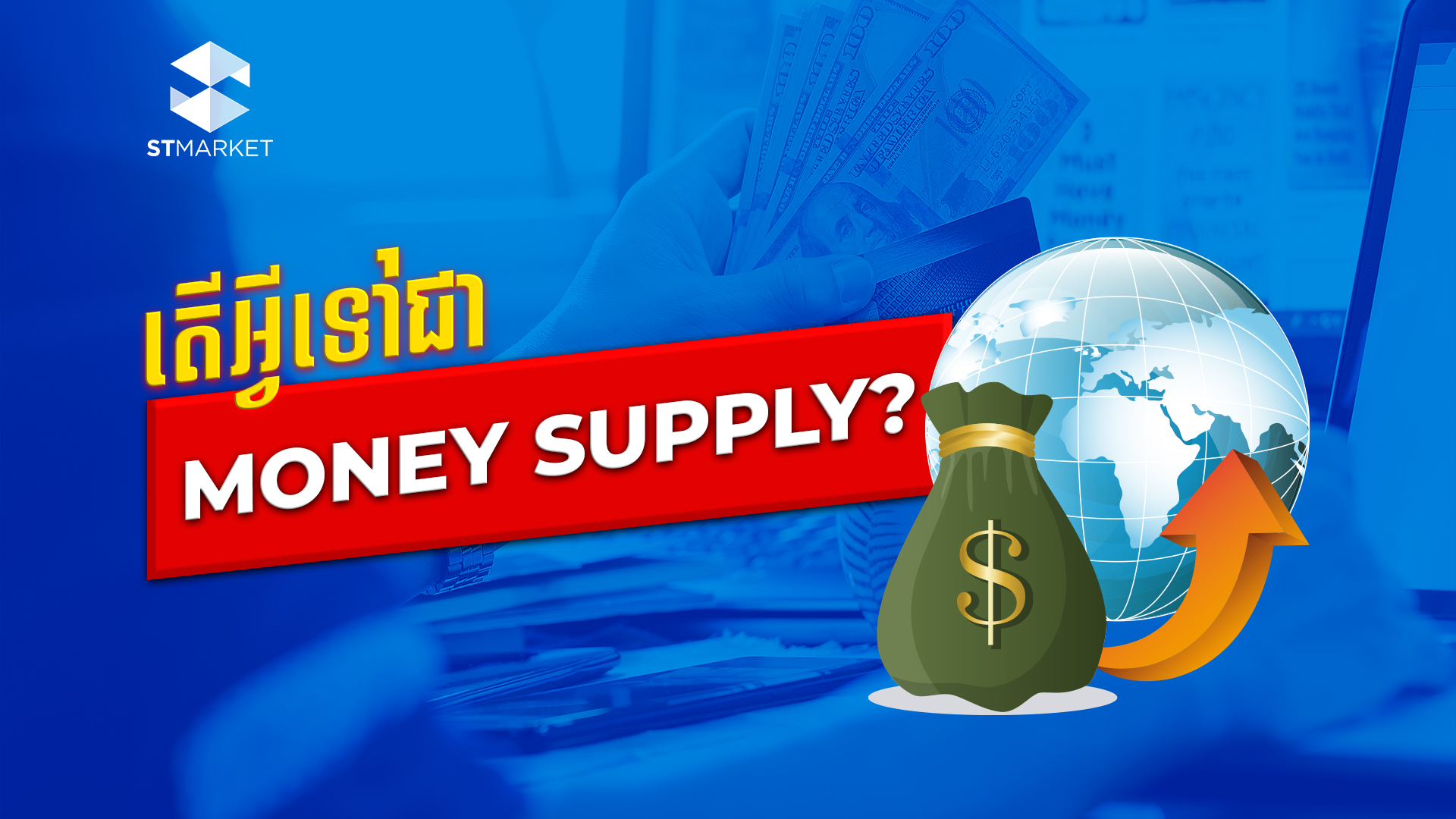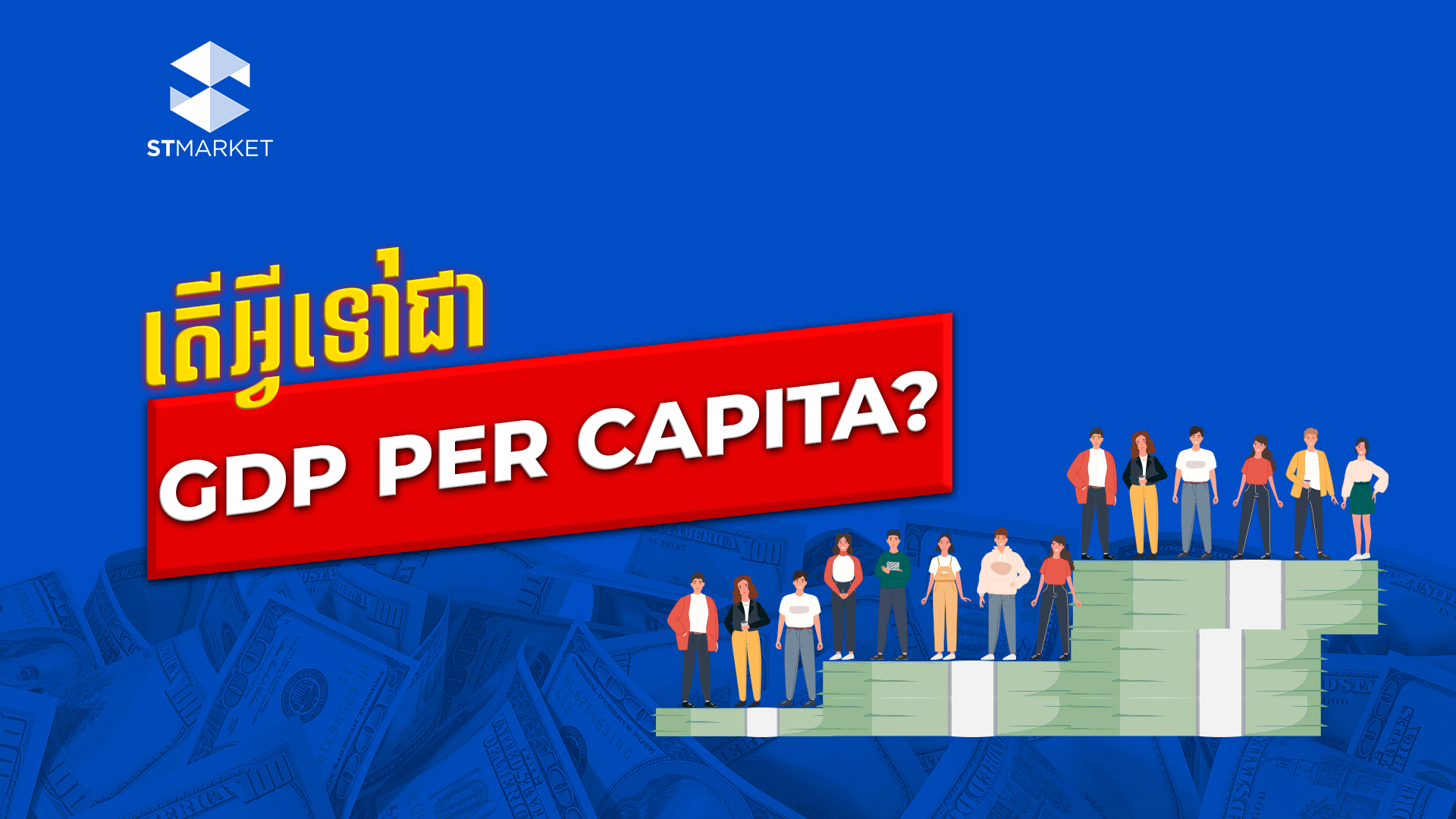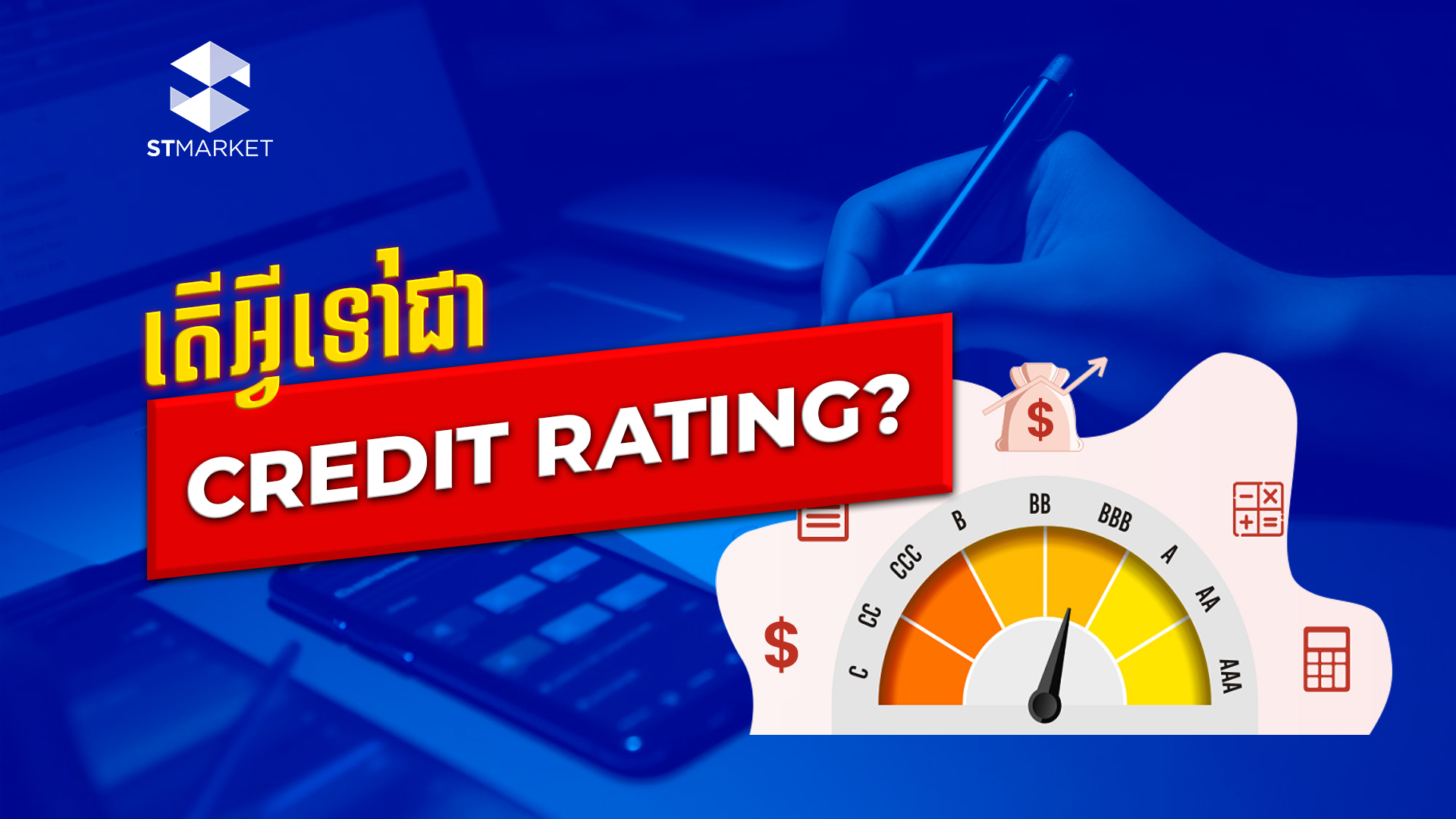⭐️ គន្លឹះសំខាន់– សូចនាករសេដ្ឋកិច្ចគឺជាតួលេខទិន្នន័យស្ថិតិដែលផ្តល់ការយល់ដឹងអំពីស្ថានភាព និងដំណើរការទូទៅនៃសេដ្ឋកិច្ច។– សូចនាករសេដ្ឋកិច្ចមានសារៈសំខាន់ណាស់ ព្រោះវាផ្តល់ព័ត៌មាន និងគោលបំណងអំពីស្ថានភាពសេដ្ឋកិច្ចទាន់ពេលវេលា ដែលអនុញ្ញាតឱ្យអ្នកបង្កើតគោលនយោបាយ និងអ្នកប្រកបអាជីវកម្មធ្វើការសម្រេចចិត្តប្រកបដោយភាពត្រឹមត្រូវ។– សូចនាករសេដ្ឋកិច្ចត្រូវបានបែងចែកជាបីក្រុមធំៗគឺ សូចនាករនាំមុខ, សូចនាករយឺតយ៉ាវ និងសូចនាករស្របគ្នា។– សូចនាករសេដ្ឋកិច្ច គឺជារង្វាស់ដ៏សំខាន់ដែលផ្តល់នូវរូបភាពនៃស្ថានភាព និងដំណើរការទូទៅរបស់សេដ្ឋកិច្ច។– សូចនាករសេដ្ឋកិច្ចមានសារៈសំខាន់ណាស់ក្នុងការសម្រេចចិត្តលើវិស័យផ្សេងៗ។ ⭐️ ឈ្វេងយល់ពីសូចនាករសេដ្ឋកិច្ចសូចនាករសេដ្ឋកិច្ចគឺជាតួលេខទិន្នន័យស្ថិតិដែលផ្តល់ការយល់ដឹងអំពីស្ថានភាព និងដំណើរការទូទៅនៃសេដ្ឋកិច្ច។ សូចនាករសេដ្ឋកិច្ចជួយឱ្យអ្នកវិភាគ អ្នកបង្កើតគោលនយោបាយ និងអ្នកប្រកបអាជីវកម្មអាចវាយតម្លៃពីនិន្នាការសេដ្ឋកិច្ច ធ្វើការសម្រេចចិត្តប្រកបដោយត្រឹមត្រូវ និងវាយតម្លៃពីផលប៉ះពាល់នៃកត្តាផ្សេងៗមកលើសេដ្ឋកិច្ច។ ⭐️ សមាសធាតុសំខាន់ៗនៃសូចនាករសេដ្ឋកិច្ចសូចនាករសេដ្ឋកិច្ចមានសារៈសំខាន់ណាស់ ព្រោះវាផ្តល់ព័ត៌មាន និងគោលបំណងអំពីស្ថានភាពសេដ្ឋកិច្ចទាន់ពេលវេលា ដែលអនុញ្ញាតឱ្យអ្នកបង្កើតគោលនយោបាយ និងអ្នកប្រកបអាជីវកម្មធ្វើការសម្រេចចិត្តប្រកបដោយភាពត្រឹមត្រូវ។ តាមរយៈការតាមដានសូចនាករទាំងនេះ អ្នកពាក់ព័ន្ធអាចវាយតម្លៃស្ថិរភាពសេដ្ឋកិច្ច ទស្សន៍ទាយពីនិន្នាការសក្តានុពល និងអនុវត្តយុទ្ធសាស្ត្រដើម្បីកាត់បន្ថយហានិភ័យ និងជំរុញឱ្យមានកំណើនសេដ្ឋកិច្ច។ ⭐️ ប្រភេទនៃសូចនាករសេដ្ឋកិច្ចសូចនាករសេដ្ឋកិច្ចត្រូវបានបែងចែកជាបីក្រុមធំៗគឺ៖ – សូចនាករនាំមុខ៖ សូចនាករនាំមុខ គឺជាសំណុំទិន្នន័យដែលវាស់វែងបាន និងអាចជួយព្យាករណ៍ពីសកម្មភាពសេដ្ឋកិច្ចនាពេលអនាគត។ សូចនាករសេដ្ឋកិច្ចនាំមុខត្រូវបានប្រើប្រាស់ដើម្បីទស្សន៍ទាយពីការផ្លាស់ប្តូរនៅក្នុងសេដ្ឋកិច្ច មុនពេលសេដ្ឋកិច្ចចាប់ផ្តើមផ្លាស់ប្តូរក្នុងទិសដៅជាក់លាក់ណាមួយ។ – សូចនាករយឺតយ៉ាវ៖ សូចនាករយឺតយ៉ាវ គឺជាសូចនាករសេដ្ឋកិច្ចដែលអាចសង្កេត ឬវាស់វែងបាន ហើយមានការផ្លាស់ប្តូរបន្ទាប់ពីមានការប្រែប្រួលនៅក្នុងសេដ្ឋកិច្ច ហិរញ្ញវត្ថុ ឬអាជីវកម្មណាមួយ។ សូចនាករយឺតយ៉ាវក៏បញ្ជាក់ និងផ្លាស់ប្តូរពីនិន្នាការសេដ្ឋកិច្ចបានផងដែរ។ – សូចនាករស្របគ្នា៖ សូចនាករស្របគ្នា គឺជាសូចនាករដែលបង្ហាញពីស្ថានភាពបច្ចុប្បន្ននៃសកម្មភាពសេដ្ឋកិច្ចនៅក្នុងតំបន់ជាក់លាក់ណាមួយ។ ដូចនេះ សូចនាករសេដ្ឋកិច្ចអាចផ្តល់នូវការយល់ដឹងអំពីទិដ្ឋភាពផ្សេងៗនៃសេដ្ឋកិច្ច ដូចជាអត្រាការងារ អតិផរណា ពាណិជ្ជកម្ម និងសុខភាពសេដ្ឋកិច្ចទាំងមូល។ ⭐️ សូចនាករសេដ្ឋកិច្ចសំខាន់ៗសូចនាករសេដ្ឋកិច្ច គឺជារង្វាស់ដ៏សំខាន់ដែលផ្តល់នូវរូបភាពនៃស្ថានភាព និងដំណើរការទូទៅរបស់សេដ្ឋកិច្ច។ ខាងក្រោមនេះ គឺជាសូចនាករសេដ្ឋកិច្ចសំខាន់ៗមួយចំនួនដូចជា៖ 1. ផលិតផលក្នុងស្រុកសរុប (GDP)៖ ផលិតផលក្នុងស្រុកសរុប (GDP) វាស់តម្លៃសរុបនៃទំនិញ និងសេវាកម្មទាំងអស់ដែលផលិតក្នុងប្រទេសមួយក្នុងរយៈពេលជាក់លាក់មួយ។ វាគឺជាសូចនាករមូលដ្ឋាន ដែលប្រាប់ពីទំហំ និងកំណើនសេដ្ឋកិច្ច។ 2. អត្រាគ្មានការងារធ្វើ៖ សូចនាករនេះឆ្លុះបញ្ចាំងពីភាគរយនៃកម្លាំងពលកម្មដែលកំពុងគ្មានការងារធ្វើ និងកំពុងស្វែងរកការងារធ្វើយ៉ាងសកម្ម។ វាផ្តល់នូវការយល់ដឹងអំពីសុខភាពរបស់ទីផ្សារការងារ និងលទ្ធភាពទទួលបានការងារធ្វើ។ 3. អត្រាអតិផរណា៖ អត្រាអតិផរណាវាស់ពីកម្រិតតម្លៃទូទៅនៃទំនិញ និងសេវាកម្មដែលកើនឡើងតាមពេលវេលាជាក់លាក់ណាមួយ។ វាក៏ជួយវាយតម្លៃអំណាចទិញនៃរូបិយប័ណ្ណ និងជះឥទ្ធិពលទៅលើអ្នកប្រើប្រាស់ និងអាជីវកម្មបានផងដែរ។ 4. សន្ទស្សន៍តម្លៃទំនិញប្រើប្រាស់ (CPI)៖ សន្ទស្សន៍តម្លៃទំនិញប្រើប្រាស់ (CPI) តាមដានការផ្លាស់ប្តូរតម្លៃនៃកញ្ចប់ទំនិញ និងសេវាកម្មដែលជាទូទៅត្រូវបានទិញដោយគ្រួសារ។ វាជាសូចនាករយ៉ាងសំខាន់សម្រាប់ធ្វើការវាយតម្លៃពីការប្រែប្រួលនៃតម្លៃជីវភាពរស់នៅ។ 5. សន្ទស្សន៍តម្លៃអ្នកផលិត (PPI)៖ PPI វាស់វែងការផ្លាស់ប្តូរជាមធ្យមនៃតម្លៃលក់ដែលទទួលបានដោយអ្នកផលិតក្នុងស្រុកសម្រាប់ទំនិញ និងសេវាកម្មរបស់ពួកគេតាមពេលវេលាជាក់លាក់ណាមួយ។ វាផ្តល់នូវការយល់ដឹងអំពីសម្ពាធនៃការចំណាយក្នុងដំណើរការផលិត។ 6. តុល្យភាពពាណិជ្ជកម្ម៖ សូចនាករនេះបង្ហាញពីភាពខុសគ្នារវាងការនាំចេញ និងការនាំចូលរបស់ប្រទេសមួយ។ សមតុល្យវិជ្ជមានបង្ហាញពីអតិរេកពាណិជ្ជកម្ម ខណៈពេលដែលសមតុល្យអវិជ្ជមានបង្ហាញពីឱនភាពពាណិជ្ជកម្ម។ 7. ការលក់លក់រាយ៖ ទិន្នន័យនៃការលក់រាយឆ្លុះបញ្ចាំងពីប្រាក់ចំណូលសរុបដែលបង្កើតដោយគ្រឹះស្ថានលក់រាយក្នុងរយៈពេលជាក់លាក់មួយ។ វាផ្តល់នូវការយល់ដឹងអំពីនិន្នាការនៃការចំណាយរបស់អ្នកប្រើប្រាស់។ 8. ផលិតកម្មឧស្សាហកម្ម៖ សូចនាករនេះវាស់វែងលើទិន្នផលនៃវិស័យផលិតកម្ម ការជីកយករ៉ែ និងឧបករណ៍ប្រើប្រាស់ផ្សេងៗ។ វាផ្តល់នូវការយល់ដឹងអំពីសុខភាពទូទៅនៃវិស័យឧស្សាហកម្ម។ 9. សន្ទស្សន៍ទំនុកចិត្តអ្នកប្រើប្រាស់៖ សន្ទស្សន៍នេះស្ទង់មើលអាកប្បកិរិយា និងការរំពឹងទុករបស់អ្នកប្រើប្រាស់ទាក់ទងនឹងដំណើរការអនាគតរបស់សេដ្ឋកិច្ច។ វាអាចបង្ហាញពីអារម្មណ៍អតិថិជន និងឆន្ទៈក្នុងការចំណាយ។ 10. សន្ទស្សន៍ទំនុកចិត្តអាជីវកម្ម៖ ស្រដៀងទៅនឹងសន្ទស្សន៍ទំនុកចិត្តអ្នកប្រើប្រាស់ដែរ សូចនាករនេះវាស់វែងពីសន្ទស្សន៍អារម្មណ៍ និងការរំពឹងទុករបស់អាជីវកម្ម ដែលទាក់ទងនឹងលក្ខខណ្ឌសេដ្ឋកិច្ចផ្សេងៗ។ វាផ្តល់នូវការយល់ដឹងអំពីការសម្រេចចិត្តវិនិយោគរបស់ក្រុមហ៊ុន។ 11. សូចនាករទីផ្សារលំនៅឋាន៖ ទាំងនេះរួមបញ្ចូលនូវទិន្នន័យស្តីពីការចាប់ផ្តើមសាងសង់លំនៅឋាន ការលក់ផ្ទះ និងតម្លៃផ្ទះ ដែលជាកត្តាយ៉ាងសំខាន់សម្រាប់ធ្វើការវាយលើតម្លៃសុខភាពទីផ្សារអចលនទ្រព្យ ក៏ដូចជាផលប៉ះពាល់របស់វាទៅលើសេដ្ឋកិច្ចទាំងមូលផងដែរ។ 12. អត្រាការប្រាក់៖ ធនាគារកណ្តាលកំណត់អត្រាការប្រាក់ ដែលមានឥទ្ធិពលលើការចំណាយលើប្រាក់កម្ចីសម្រាប់បុគ្គល និងអាជីវកម្ម។ ការប្រែប្រួលនៃអត្រាការប្រាក់អាចប៉ះពាល់ដល់ការវិនិយោគ ការផ្តល់ប្រាក់កម្ចី និងសកម្មភាពសេដ្ឋកិច្ចទាំងមូល។ សូចនាករសេដ្ឋកិច្ចសំខាន់ៗទាំងនេះត្រូវបានត្រួតពិនិត្យ និងវិភាគជាទៀងទាត់ដោយអ្នកបង្កើតគោលនយោបាយ អ្នកប្រកបអាជីវកម្ម និងអ្នកសេដ្ឋកិច្ច ដើម្បីវាយតម្លៃពីស្ថានភាពសេដ្ឋកិច្ច ធ្វើការសម្រេចចិត្តប្រកបដោយត្រឹមត្រូវ និងប្រមើលមើលពីនិន្នាការសេដ្ឋកិច្ចដែលមានសក្តានុពល។ ⭐️ ការប្រើប្រាស់សូចនាករសេដ្ឋកិច្ចសម្រាប់ធ្វើការសម្រេចចិត្តសូចនាករសេដ្ឋកិច្ចមានសារៈសំខាន់ណាស់ក្នុងការសម្រេចចិត្តលើវិស័យផ្សេងៗ។ អាជីវកម្មប្រើប្រាស់វាដើម្បីវាយតម្លៃស្ថានភាពទីផ្សារ រៀបចំផែនការវិនិយោគ និងធ្វើការសម្រេចចិត្តលើតម្លៃ និងផលិតកម្ម។ អ្នកបង្កើតគោលនយោបាយពឹងផ្អែកលើសូចនាករទាំងនេះដើម្បីបង្កើតគោលនយោបាយសេដ្ឋកិច្ចប្រកបដោយប្រសិទ្ធភាព ខណៈពេលដែលបុគ្គលទូទៅប្រើប្រាស់វាដើម្បីជួយក្នុងការជ្រើសរើសនូវជម្រើសហិរញ្ញវត្ថុផ្ទាល់ខ្លួនដូចជាការវិនិយោគ ការសន្សំ និងការសម្រេចចិត្តក្នុងវិស័យការងារ។ | English Version | ⭐️ Key takeaway– Economic indicators are statistical data points that provide insights into the overall health and performance of an economy.– Economic indicators are crucial because they offer timely and objective information about the state of an economy, enabling policymakers and businesses to make informed decisions.– Economic indicators are categorized into three main groups, which are Leading Indicator, Lagging Indicator, and Coincident Indicator.– Key economic indicators are critical metrics that provide a snapshot of an economy’s overall health and performance.– Economic indicators are essential for decision-making across various sectors. ⭐️ Understanding about Economic IndicatorEconomic indicators are statistical data points that provide insights into the overall health and performance of an economy. They help analysts, policymakers, and businesses assess economic trends, make informed decisions, and gauge the impact of various factors on the economy. ⭐️ Importance of Economic IndicatorsEconomic indicators are crucial because they offer timely and objective information about the state of an economy, enabling policymakers and businesses to make informed decisions. By tracking these indicators, stakeholders can assess economic stability, predict potential trends, and implement strategies to mitigate risks and promote growth. ⭐️ Types of Economic IndicatorsEconomic indicators are categorized into three main groups, which are: – Leading Indicator: A leading indicator is a measurable set of data that may help to forecast future economic activity. Leading economic indicators can be used to predict changes in the economy before the economy begins to shift in a particular direction. – Lagging Indicator: A lagging indicator is an observable or measurable factor that changes sometime after the economic, financial, or business variable with which it is correlated changes. Lagging indicators confirm trends and changes in trends. – Coincident Indicator: A coincident indicator is a metric that shows the contemporaneous state of economic activity within a particular area. Therefore, economic indicators can provide insights into different aspects of the economy, such as employment, inflation, trade, and overall economic health. ⭐️ Key Economic IndicatorsKey economic indicators are critical metrics that provide a snapshot of an economy’s overall health and performance. Here are some of the most important key economic indicators: 1. Gross Domestic Product (GDP): GDP measures the total value of all goods and services produced within a country’s borders over a specific period. It is a fundamental indicator of an economy’s size and growth. 2. Unemployment Rate: This indicator reflects the percentage of the labor force that is currently unemployed and actively seeking employment. It provides insights into the labor market’s health and job availability. 3. Inflation Rate: Inflation measures the rate at which the general price level of goods and services rises over time. It helps assess the purchasing power of a currency and its impact on consumers and businesses. 4. Consumer Price Index (CPI): The CPI tracks changes in the prices of a basket of goods and services commonly purchased by households. It is a key indicator for assessing changes in the cost of living. 5. Producer Price Index (PPI): PPI measures the average change in the selling prices received by domestic producers for their goods and services over time. It offers insights into cost pressures in the production process. 6. Balance of Trade: This indicator shows the difference between a country’s exports and imports. A positive balance indicates a trade surplus, while a negative balance indicates a trade deficit. 7. Retail Sales: Retail sales data reflect the total revenue generated by retail establishments in a given period. It offers insights into consumer spending trends. 8. Industrial Production: This indicator measures the output of the manufacturing, mining, and utility sectors. It provides insights into the overall health of the industrial sector. 9. Consumer Confidence Index: This index surveys consumer attitudes and expectations regarding the economy’s future performance. It can signal consumer sentiment and willingness to spend. 10. Business Confidence Index: Similar to the consumer confidence index, this measures the sentiment and expectations of businesses regarding economic conditions. It can provide insights into corporate investment decisions. 11. Housing Market Indicators: These include data on housing starts, home sales, and home prices, which are crucial for assessing the real estate market’s health and its impact on the broader economy. 12. Interest Rates: Central banks set interest rates, which influence borrowing costs for individuals and businesses. Changes in interest rates can affect investment, lending, and overall economic activity. These key economic indicators are regularly monitored and analyzed by policymakers, businesses, and economists to assess economic conditions, make informed decisions, and anticipate potential economic trends. ⭐️ Using Economic Indicators for Decision-MakingEconomic indicators are essential for decision-making across various sectors. Businesses use them to assess market conditions, plan investments, and make pricing and production decisions. Policymakers rely on these indicators to formulate effective economic policies, while individuals use them to inform personal financial choices such as investments, savings, and employment decisions.
Understanding about Exchange Rate
⭐️ គន្លឹះសំខាន់– អត្រាប្តូរប្រាក់សំដៅលើតម្លៃដែលរូបិយប័ណ្ណមួយអាចប្តូរទៅរូបិយប័ណ្ណមួយផ្សេងទៀតនៅក្នុងទីផ្សារប្តូរប្រាក់។– ប្រភេទនៃអត្រាប្តូរប្រាក់មានពីរប្រភេទគឺ អត្រាប្តូរប្រាក់ថេរ និងអត្រាប្តូរប្រាក់អណ្តែត។– អត្រាប្តូរប្រាក់មានសារៈសំខាន់ណាស់ ព្រោះវាដើរតួយ៉ាងសំខាន់ក្នុងពាណិជ្ជកម្មអន្តរជាតិ ដែលមានឥទ្ធិពលលើការប្រកួតប្រជែងនៃទំនិញ និងសេវាកម្មនៅក្នុងទីផ្សារពិភពលោក។– វិធីសាស្រ្តព្យាករណ៍ទាំងនេះ (ការវិភាគបច្ចេកទេស, ការវិភាគជាមូលដ្ឋាន និងការវិភាគសន្ទស្សន៍អារម្មណ៍ទីផ្សារ) គឺជាឧបករណ៍សំខាន់សម្រាប់អាជីវកម្ម និងអ្នកវិនិយោគដែលស្វែងរកការសម្រេចចិត្តប្រកបដោយការយល់ដឹងនៅក្នុងទីផ្សារប្តូរប្រាក់បរទេសដែលមានថាមពល។– ទំនាក់ទំនងរវាងអត្រាប្តូរប្រាក់ និងពាណិជ្ជកម្មអន្តរជាតិ។ ⭐️ ឈ្វេងយល់ពីអត្រាប្តូរប្រាក់អត្រាប្តូរប្រាក់សំដៅលើតម្លៃដែលរូបិយប័ណ្ណមួយអាចប្តូរទៅរូបិយប័ណ្ណមួយផ្សេងទៀតនៅក្នុងទីផ្សារប្តូរប្រាក់។ អត្រាប្តូរប្រាក់មានសារៈសំខាន់សម្រាប់ពាណិជ្ជកម្ម និងហិរញ្ញវត្ថុអន្តរជាតិណាស់ ដោយសារតែវាជួយកំណត់តម្លៃទំនិញ និងសេវាកម្ម ក៏ដូចជាផលចំណេញនៃប្រតិបត្តិការនីមួយៗពីប្រទេសមួយទៅប្រទេសមួយ។ ⭐️ សារៈសំខាន់នៃអត្រាប្តូរប្រាក់អត្រាប្តូរប្រាក់មានសារៈសំខាន់ណាស់ ព្រោះវាដើរតួយ៉ាងសំខាន់ក្នុងពាណិជ្ជកម្មអន្តរជាតិ ដែលមានឥទ្ធិពលលើការប្រកួតប្រជែងនៃទំនិញ និងសេវាកម្មនៅក្នុងទីផ្សារពិភពលោក។ អត្រាប្តូរប្រាក់ក៏មានឥទ្ធិពលលើលំហូរមូលធន ការសម្រេចចិត្តវិនិយោគ និងអាចជះឥទ្ធិពលដល់ស្ថិរភាព និងកំណើនសេដ្ឋកិច្ចទាំងមូលរបស់ប្រទេសមួយបានផងដែរ។ ⭐️ ប្រភេទនៃអត្រាប្តូរប្រាក់– អត្រាប្តូរប្រាក់ថេរ៖ នៅក្នុងប្រព័ន្ធអត្រាប្តូរប្រាក់ថេរ រដ្ឋាភិបាលបង្កើត និងទ្រទ្រង់អត្រាប្តូរប្រាក់ជាក់លាក់មួយសម្រាប់រូបិយប័ណ្ណរបស់ខ្លួន ជាធម្មតាទាក់ទងនឹងរូបិយប័ណ្ណផ្សេងទៀត ឬទ្រព្យសម្បត្តិដ៏មានតម្លៃដូចជាមាស។ គោលបំណងចម្បងនៃការបង្កើតអត្រាប្តូរប្រាក់ប្រភេទនេះ គឺដើម្បីរក្សាស្ថិរភាពក្នុងពាណិជ្ជកម្មអន្តរជាតិ និងលំហូរមូលធននៅក្នុងប្រទេស។ – អត្រាប្តូរប្រាក់អណ្តែត៖ អត្រាប្តូរប្រាក់ប្រភេទនេះត្រូវបានកំណត់ដោយទីផ្សារឯកជនតាមរយៈការប៉ាន់ស្មាន ការផ្គត់ផ្គង់ និងតម្រូវការ និងកត្តាផ្សេងៗទៀតនៅក្នុងទីផ្សារប្តូរប្រាក់បរទេស។ ម្យ៉ាងវិញទៀត អត្រាប្តូរប្រាក់ប្រភេទនេះត្រូវបានគេហៅថា អត្រាប្តូរប្រាក់អណ្តែត ឬអត្រាប្តូរប្រាក់ឥតគិតថ្លៃផងដែរ។ ⭐️ កត្តាដែលជះឥទ្ធិពលលើអត្រាប្តូរប្រាក់អត្រាប្តូរប្រាក់ត្រូវបានរងឥទ្ធិពលដោយកត្តាផ្សេងៗ ដែលក្នុងនោះរួមមាន អត្រាការប្រាក់ អត្រាអតិផរណា និងដំណើរការសេដ្ឋកិច្ចរបស់ប្រទេសមួយ។ ស្ថិរភាពនយោបាយ សន្ទស្សន៍ទីផ្សារ និងគោលនយោបាយរបស់រដ្ឋាភិបាលក៏ដើរតួនាទីយ៉ាងសំខាន់ក្នុងការគ្រប់គ្រងអត្រាប្តូរប្រាក់ដែរ។ លើសពីនេះទៅទៀត ព្រឹត្តិការណ៍សកល អន្តរាគមន៍របស់ធនាគារកណ្តាល សមតុល្យពាណិជ្ជកម្ម និងភាពខុសគ្នានៃអត្រាការប្រាក់ក៏អាចប៉ះពាល់ដល់អត្រាប្តូរប្រាក់ផងដែរ។ ពាណិជ្ជករ វិនិយោគិន និងធនាគារកណ្តាលតែងតែតាមដានយ៉ាងដិតដល់ចំពោះឥទ្ធិពលរបស់កត្តាទាំងនោះមកលើតម្លៃរូបិយប័ណ្ណ។ ⭐️ ការព្យាករណ៍អត្រាប្តូរប្រាក់វិធីសាស្រ្តព្យាករណ៍ទាំងបីខាងក្រោមនេះគឺជាឧបករណ៍សំខាន់សម្រាប់អាជីវកម្ម និងអ្នកវិនិយោគដែលស្វែងរកការសម្រេចចិត្តប្រកបដោយការយល់ដឹងនៅក្នុងទីផ្សារប្តូរប្រាក់បរទេសដែលមានថាមពល។ – ការវិភាគបច្ចេកទេស៖ ពិនិត្យមើលទិន្នន័យតម្លៃចាស់ និងលំនាំដើម្បីទស្សន៍ទាយពីចលនានៃអត្រាប្តូរប្រាក់នាពេលអនាគតដោយផ្អែកលើនិន្នាការ និងការវិភាគក្រាហ្វ។ – ការវិភាគជាមូលដ្ឋាន៖ វាយតម្លៃលើសូចនាករសេដ្ឋកិច្ច គោលនយោបាយរបស់រដ្ឋាភិបាល និងកត្តាម៉ាក្រូសេដ្ឋកិច្ច ដើម្បីព្យាករណ៍ពីអត្រាប្តូរប្រាក់ដោយផ្អែកលើមូលដ្ឋានសេដ្ឋកិច្ចជាមូលដ្ឋាន។ – ការវិភាគសន្ទស្សន៍អារម្មណ៍ទីផ្សារ៖ ការវាយតម្លៃពីសន្ទស្សន៍អារម្មណ៍ទីផ្សារ និងប្រតិកម្មចំពោះព្រឹត្តិការណ៍ព័ត៌មាន និងកត្តាភូមិសាស្ត្រនយោបាយ ដើម្បីវាស់ស្ទង់ពីរបៀបដែលពួកគេអាចមានឥទ្ធិពលលើចលនាអត្រាប្តូរប្រាក់។ ⭐️ អត្រាប្តូរប្រាក់ និងពាណិជ្ជកម្មអន្តរជាតិ– ផលប៉ះពាល់លើការនាំចេញ និងនាំចូល៖អត្រាប្តូរប្រាក់ដើរតួនាទីយ៉ាងសំខាន់ក្នុងពាណិជ្ជកម្មអន្តរជាតិ។ នៅពេលដែលរូបិយប័ណ្ណរបស់ប្រទេសមួយធ្លាក់ចុះបើធៀបទៅនឹងរូបិយប័ណ្ណផ្សេងទៀត នោះការនាំចេញរបស់ប្រទេសនោះកាន់តែមានតម្លៃគួរឱ្យទាក់ទាញសម្រាប់បរទេស។ នេះអាចជម្រុញឱ្យមានចំនួននៃការនាំចេញច្រើន ពីព្រោះអតិថិជនបរទេសអាចទិញទំនិញ និងសេវាកម្មរបស់ខ្លួនកាន់តែច្រើនក្នុងបរិមាណដូចគ្នានៃរូបិយប័ណ្ណផ្ទាល់ខ្លួនរបស់ពួកគេ។ ផ្ទុយទៅវិញ ប្រសិនបើតម្លៃរូបិយប័ណ្ណក្នុងស្រុកកាន់តែឡើងថ្លៃ នោះធ្វើឱ្យតម្លៃនៃការនាំចេញរបស់ប្រទេសមួយមានតម្លៃថ្លៃសម្រាប់អ្នកទិញបរទេស ដែលអាចកាត់បន្ថយចំនួននៃការនាំចេញ ប៉ុន្តែធ្វើឱ្យការនាំចូលមានតម្លៃថោកទៅវិញ។ – ជញ្ជីងពាណិជ្ជកម្ម៖ជញ្ជីងពាណិជ្ជកម្មគឺជាភាពខុសគ្នារវាងតម្លៃនៃការនាំចេញ និងការនាំចូលរបស់ប្រទេសមួយ។ អត្រាប្តូរប្រាក់អាចប៉ះពាល់ដោយផ្ទាល់ដល់ជញ្ជីងពាណិជ្ជកម្ម។ នៅពេលដែលរូបិយប័ណ្ណរបស់ប្រទេសមួយមានភាពទន់ខ្សោយ ប្រទេសនោះនឹងមានអតិរេកពាណិជ្ជកម្ម ដោយសារតែការនាំចេញមានតម្លៃថោក ដូច្នេះចំនួននៃការនាំចេញក៏កើនឡើងផងដែរ។ ផ្ទុយទៅវិញ ប្រសិនបើតម្លៃរូបិយប័ណ្ណកាន់តែរឹងមាំ នោះអាចនាំឱ្យមានឱនភាពពាណិជ្ជកម្ម ដោយសារតែតម្លៃរូបិយប័ណ្ណរបស់ប្រទេសនោះមានតម្លៃថ្លៃ ធ្វើឱ្យការនាំចេញតិចជាងការនាំចូល។ សរុបមក ការបកស្រាយខាងលើបានបង្ហាញពីភាពប្រែប្រួលនៃអត្រាប្តូរប្រាក់ ដែលមានឥទ្ធិពលមកលើពាណិជ្ជកម្មអន្តរជាតិរបស់ប្រទេសមួយ ដោយសារតែផលប៉ះពាល់ក្នុងការប្រកួតប្រជែងរវាងការនាំចេញ និងការនាំចូល។ ជាងនេះទៅទៀត ការយល់ដឹងអំពីសក្ដានុពលទាំងនេះគឺមានសារៈសំខាន់សម្រាប់អាជីវកម្ម រដ្ឋាភិបាល និងអ្នកបង្កើតគោលនយោបាយដែលពាក់ព័ន្ធខ្លាំងណាស់ក្នុងការធ្វើផែនការពាណិជ្ជកម្ម និងសេដ្ឋកិច្ចពិភពលោក។ | English Version | ⭐️ Key takeaway– Exchange rate refer to the value at which one currency can be exchanged for another, representing the relative worth of one currency in comparison to another in the global foreign exchange market.– There are 2 types of Exchange Rate which are: Fixed exchange rate, and Managed Floating Exchange Rate.– Exchange rate are important because they play a pivotal role in international trade, affecting the competitiveness of goods and services in global markets.– The three forecasting methods (Technical Analysis, Fundamental Analysis, and Sentiment Analysis) are essential tools for businesses and investors seeking to make informed decisions in the dynamic foreign exchange market.– Relationship between Exchange Rate and International Trade. ⭐️ Understanding about Exchange RateExchange rate refer to the value at which one currency can be exchanged for another, representing the relative worth of one currency in comparison to another in the global foreign exchange market. These rates are crucial for international trade and finance, as they determine the cost of goods and services, as well as the profitability of cross-border transactions. ⭐️ Importance of Exchange RateExchange rate are important because they play a pivotal role in international trade, affecting the competitiveness of goods and services in global markets. They also influence capital flows, investment decisions, and can impact a country’s overall economic stability and growth. ⭐️ Types of Exchange Rate– Fixed exchange rate: In a fixed exchange rate system, a government establishes and sustains a specific exchange rate for its currency, typically in relation to another currency or a valuable asset like gold. The primary aim is to maintain stability in international trade and capital flows. – Managed Floating Exchange Rate: Under this system, the exchange rate for the currency is fixed by the forces of demand and supply of different currencies in the foreign exchange market. This system is also called the Floating Rate of Exchange or Free Exchange Rate. ⭐️ Factors Influencing Exchange RateExchange rate are influenced by a complex interplay of factors. Key determinants include interest rates, inflation rates, and a country’s economic performance. Political stability, market sentiment, and government policies also play crucial roles. Additionally, global events, central bank interventions, trade balances, and interest rate differentials impact exchange rates. These factors interact dynamically, with traders, investors, and central banks closely monitoring them for their effects on currency values. ⭐️ Exchange Rate ForecastingThe three forecasting methods below are essential tools for businesses and investors seeking to make informed decisions in the dynamic foreign exchange market. – Technical Analysis: Examining historical price data and patterns to predict future exchange rate movements based on trends and chart analysis. – Fundamental Analysis: Evaluating economic indicators, government policies, and macroeconomic factors to forecast exchange rate based on the underlying economic fundamentals. – Sentiment Analysis: Assessing market sentiment and reactions to news events and geopolitical factors to gauge how they might influence exchange rate movements. ⭐️ Exchange Rate and International Trade– Impact on Exports and Imports:Exchange rate plays a significant role in international trade. When a country’s currency weakens compared to other currencies, its exports become more attractively priced for foreign buyers. This can boost a country’s exports because foreign customers can purchase more of its goods and services for the same amount of their own currency. Conversely, a stronger domestic currency makes a country’s exports more expensive for foreign buyers, which can reduce exports but make imports cheaper. – Trade Balance:The trade balance is the difference between the value of a country’s exports and imports. Exchange rate can directly impact the trade balance. When a country’s currency is weaker, it tends to have a trade surplus because its cheaper exports are in high demand. In contrast, a stronger currency can lead to a trade deficit because imports become more attractive due to their lower cost in terms of the stronger currency. In summary, the above explanation highlights how fluctuations in exchange rate can influence a country’s international trade by affecting the competitiveness of its exports and imports. Understanding these dynamics is crucial for businesses, governments, and policymakers involved in global trade and economic planning.
Understanding about the Balance of Payments
⭐️ គន្លឹះសំខាន់– តុល្យភាពនៃការទូទាត់ ឬ Balance of Payment (BoP) គឺជាការកត់ត្រាជាប្រព័ន្ធនៃប្រតិបត្តិការសេដ្ឋកិច្ចទាំងអស់រវាងអ្នករស់នៅក្នុងប្រទេសមួយ និងប្រទេសផ្សេងទៀតនៃពិភពលោកក្នុងរយៈពេលជាក់លាក់មួយ។– BoP ត្រូវបានបែងចែកជាបីផ្នែកសំខាន់ៗ ដូចជា៖ គណនីចរន្ត, គណនីមូលធន និងគណនីហិរញ្ញវត្ថុ។– សមតុល្យនៃការទូទាត់ត្រូវបានរំពឹងថានឹងមានតុល្យភាព មានន័យថាផលបូកនៃគណនីចរន្ត គណនីដើមទុន និងគណនីហិរញ្ញវត្ថុគួរតែស្មើសូន្យ។ ⭐️ ឈ្វេងយល់ពីតុល្យភាពនៃការទូទាត់តុល្យភាពនៃការទូទាត់ ឬ BoP គឺជាការកត់ត្រាជាប្រព័ន្ធនៃប្រតិបត្តិការសេដ្ឋកិច្ចទាំងអស់រវាងអ្នករស់នៅក្នុងប្រទេសមួយ (ប្រទេសដែលធ្វើរបាយការណ៍) និងប្រទេសផ្សេងទៀតនៃពិភពលោកក្នុងរយៈពេលជាក់លាក់មួយ ដែលជាធម្មតាក្នុងមួយឆ្នាំ ឬមួយត្រីមាស។ វាគឺជាប្រព័ន្ធគណនេយ្យដ៏ទូលំទូលាយមួយដែលតាមដាននូវលំហូរសាច់ប្រាក់ និងទ្រព្យសម្បត្តិសេដ្ឋកិច្ចផ្សេងទៀតរវាងប្រទេសមួយ និងពិភពលោកទាំងមូល។ ⭐️ សមាសធាតុនៃតុល្យភាពនៃការទូទាត់ជាទូទៅ BoP ត្រូវបានបែងចែកជាបីផ្នែកសំខាន់ៗ៖1. គណនីចរន្ត៖ គណនីចរន្តកត់ត្រានូវប្រតិបត្តិការដែលទាក់ទងនឹងពាណិជ្ជកម្ម ទំនិញ និងសេវាកម្ម ព្រមទាំងប្រាក់ចំណូលដែលទទួលបានពី ឬបង់ទៅឱ្យបុគ្គល និងអង្គភាពបរទេស។ វារួមបញ្ចូល៖– ការនាំចេញ និងនាំចូលទំនិញ (ពាណិជ្ជកម្មទំនិញ) ។– ការនាំចេញ និងនាំចូលសេវាកម្ម (ឧ. ទេសចរណ៍ ប្រឹក្សាយោបល់ សេវាហិរញ្ញវត្ថុ)។– ប្រាក់ចំណូលពីការវិនិយោគ (ដូចជាភាគលាភ និងការប្រាក់) ដែលទទួលបានពីបរទេស និងបង់ឱ្យជនបរទេស។– ការផ្ទេរឯកតោភាគី (អំណោយ ជំនួយបរទេស ជំនួយ និងការផ្ទេរប្រាក់)។ 2. គណនីមូលធន៖ គណនីមូលធនតាមដានពីការផ្ទេរមូលធនជាអន្តរជាតិ និងការទទួលបាន ឬការដក/លក់ចេញនូវទ្រព្យសម្បត្តិដែលមិនមែនជាទ្រព្យសកម្ម ដូចជាប៉ាតង់ ការរក្សាសិទ្ធិ និងពាណិជ្ជសញ្ញា។ វាក៏រួមបញ្ចូលផងដែរនូវប្រតិបត្តិការទាក់ទងនឹងការលើកលែងបំណុល និងការផ្ទេរកម្មសិទ្ធិនៃទ្រព្យសកម្មថេរ។ 3. គណនីហិរញ្ញវត្ថុ៖ គណនីហិរញ្ញវត្ថុកត់ត្រានូវប្រតិបត្តិការហិរញ្ញវត្ថុអន្តរជាតិ រួមទាំងការទិញ និងការដក/លក់ចេញនូវទ្រព្យសម្បត្តិ និងបំណុលហិរញ្ញវត្ថុរវាងអ្នករស់នៅ និងមិនមែននិវាសនជន។ វារួមបញ្ចូល៖– ការវិនិយោគផ្ទាល់ពីបរទេស (FDI)៖ ការវិនិយោគដែលធ្វើឡើងដោយប្រជាជនរបស់ប្រទេសមួយនៅក្នុងក្រុមហ៊ុនបរទេស និងផ្ទុយមកវិញ។– ការវិនិយោគផលប័ត្រ៖ ប្រតិបត្តិការក្នុងភាគហ៊ុន មូលបត្របំណុល និងឧបករណ៍ហិរញ្ញវត្ថុផ្សេងទៀត។– ទ្រព្យសកម្មបម្រុង៖ ប្រតិបត្តិការដែលពាក់ព័ន្ធនឹងទុនបម្រុងប្តូរប្រាក់បរទេសរបស់ធនាគារកណ្តាលរបស់ប្រទេសមួយ។– ការវិនិយោគផ្សេងទៀត៖ រួមបញ្ចូលប្រាក់កម្ចី ឥណទានពាណិជ្ជកម្ម និងប្រតិបត្តិការហិរញ្ញវត្ថុផ្សេងទៀតដែលមិនត្រូវបានចាត់ថ្នាក់ជា FDI ឬការវិនិយោគផលប័ត្រ។ សមតុល្យនៃការទូទាត់ត្រូវបានរំពឹងថានឹងមានតុល្យភាព មានន័យថាផលបូកនៃគណនីចរន្ត គណនីដើមទុន និងគណនីហិរញ្ញវត្ថុគួរតែស្មើសូន្យ។ ផ្អែកលើគោលការណ៍គណនេយ្យ រាល់ប្រតិបត្តិការអន្តរជាតិ ត្រូវតែមានឥណទាន និងឥណពន្ធដែលត្រូវគ្នា។ ប៉ុន្តែនៅក្នុងការអនុវត្តផ្ទាល់ ដោយសារភាពមិនស្របគ្នានៃស្ថិតិ និងកត្តាផ្សេងទៀត វាអាចបង្កឱ្យមានភាពមិនស្មើគ្នាបន្តិចបន្តួចនៅក្នុងទិន្នន័យដែលបានកត់ត្រា។ រដ្ឋាភិបាល និងអ្នកបង្កើតគោលនយោបាយប្រើប្រាស់ទិន្នន័យ BoP ដើម្បីវាយតម្លៃស្ថានភាពហិរញ្ញវត្ថុអន្តរជាតិរបស់ប្រទេសមួយ តាមដាននិន្នាការពាណិជ្ជកម្ម និងបង្កើតគោលនយោបាយសេដ្ឋកិច្ច។ អតិរេកនៅក្នុងគណនីចរន្តបង្ហាញថាប្រទេសមួយកំពុងនាំចេញច្រើនជាងការនាំចូល ខណៈពេលដែលឱនភាពបង្ហាញផ្ទុយពីនេះ។ ដូចគ្នានេះដែរ គណនីហិរញ្ញវត្ថុអាចបង្ហាញពីលំហូរនៃការវិនិយោគបរទេសចូល ឬចេញពីប្រទេស ដែលអាចប៉ះពាល់ដល់ស្ថិរភាពសេដ្ឋកិច្ច និងអត្រាប្តូរប្រាក់របស់ប្រទេសមួយ។ | English Version | ⭐️ Key takeaway– The Balance of Payments or Balance of Payment (BoP) is a systematic record of all economic transactions between residents of one country and the rest of the world over a specific period.– BoP is typically divided into three main components which are: Current Account, Capital Account, and Financial Account.– The balance of payments is always expected to balance, meaning that the sum of the current account, capital account, and financial account should equal zero. ⭐️ Understanding about Balance of PaymentsThe Balance of Payments or BoP is a systematic record of all economic transactions between residents of one country (the reporting country) and the rest of the world over a specific period, typically a year or a quarter. It is a comprehensive accounting system that tracks the flow of money and other economic assets between a country and the rest of the world. ⭐️ Components of Balance of PaymentsThe BoP is typically divided into three main components:1. Current Account: The current account records transactions related to the trade in goods and services, as well as income received from or paid to foreign individuals and entities. It includes:– Exports and imports of goods (merchandise trade).– Exports and imports of services (e.g., tourism, consulting, financial services).– Investment income (such as dividends and interest) received from abroad and paid to foreigners.– Unilateral transfers (gifts, foreign aid, grants, and remittances). 2. Capital Account: The capital account tracks international capital transfers and the acquisition or disposal of non-financial assets, such as patents, copyrights, and trademarks. It also includes transactions related to debt forgiveness and transfers of ownership of fixed assets. 3. Financial Account: The financial account records international financial transactions, including the acquisition and disposal of financial assets and liabilities between residents and non-residents. It includes:– Foreign direct investment (FDI): Investments made by a country’s residents in foreign companies and vice versa.– Portfolio investment: Transactions in stocks, bonds, and other financial instruments.– Reserve assets: Transactions involving a country’s central bank’s foreign exchange reserves.– Other investments: Includes loans, trade credits, and other financial transactions not classified as FDI or portfolio investments. The balance of payments is always expected to balance, meaning that the sum of the current account, capital account, and financial account should equal zero. This is based on the accounting principle that for every international transaction, there must be a corresponding credit and debit. In practice, due to statistical discrepancies and other factors, there may be slight imbalances in the recorded data. Governments and policymakers use the balance of payments data to assess a country’s international financial position, monitor trade trends, and formulate economic policies. A surplus in the current account indicates that a country is exporting more than it’s importing, while a deficit suggests the opposite. Similarly, the financial account can show the flow of foreign investments into or out of a country, which can impact a nation’s economic stability and exchange rates.
Understanding about Foreign Direct Investment (FDI)
⭐️ គន្លឹះសំខាន់– ការវិនិយោគផ្ទាល់ពីបរទេស (FDI) សំដៅលើការវិនិយោគដែលធ្វើឡើងដោយបុគ្គល អាជីវកម្ម ឬរដ្ឋាភិបាលពីប្រទេសមួយ (ប្រទេសកំណើត) ទៅប្រទេសមួយផ្សេងទៀត (ប្រទេសម្ចាស់ផ្ទះ) ដើម្បីបង្កើតផលប្រយោជន៍អាជីវកម្ម។– ការវិនិយោគផ្ទាល់ពីបរទេស (FDI) គឺជាកត្តាសំខាន់សម្រាប់សេដ្ឋកិច្ចពិភពលោក ដោយសារវាជួយជំរុញកំណើនសេដ្ឋកិច្ច បង្កើនភាពជឿនលឿនក្នុងផ្នែកបច្ចេកវិទ្យា និងបង្កើតឱកាសការងារនៅក្នុងប្រទេសម្ចាស់ផ្ទះផងដែរ។– FDI ត្រូវបានចាត់ថ្នាក់ជាបីប្រភេទគឺ៖ Horizontal FDI, Vertical FDI, and Conglomerate FDI ។– ក្រុមហ៊ុនភាគច្រើនធ្វើការបណ្តាក់ទុននៅបរទេសដើម្បីបានចូលក្នុងទីផ្សារថ្មី ពង្រីកមូលដ្ឋានអតិថិជន និងបង្កើនប្រាក់ចំណូល។ ⭐️ ឈ្វេងយល់ពីការវិនិយោគផ្ទាល់ពីបរទេស (FDI)ការវិនិយោគផ្ទាល់ពីបរទេស (FDI) សំដៅលើការវិនិយោគដែលធ្វើឡើងដោយបុគ្គល អាជីវកម្ម ឬរដ្ឋាភិបាលពីប្រទេសមួយ (ប្រទេសកំណើត) ទៅប្រទេសមួយផ្សេងទៀត (ប្រទេសម្ចាស់ផ្ទះ) ដើម្បីបង្កើតផលប្រយោជន៍អាជីវកម្ម។ ការវិនិយោគផ្ទាល់ពីបរទេសនេះពាក់ព័ន្ធនឹងការគ្រប់គ្រង ឬឥទ្ធិពលយ៉ាងសំខាន់ដោយអ្នកវិនិយោគលើការគ្រប់គ្រង ប្រតិបត្តិការ និងដំណើរការធ្វើការសម្រេចចិត្តរបស់អង្គភាពអាជីវកម្មបរទេស។ FDI អាចមានទម្រង់ផ្សេងៗគ្នា រួមទាំងការបង្កើតសាខាថ្មី ការទិញភាគហ៊ុនភាគហ៊ុននៅក្នុងអាជីវកម្មដែលមានស្រាប់ ឬការវិនិយោគក្នុងការបណ្តាក់ទុនរួមគ្នាជាមួយដៃគូក្នុងស្រុក។ FDI គឺជាធាតុផ្សំដ៏សំខាន់នៃសមាហរណកម្មសេដ្ឋកិច្ចអន្តរជាតិ និងដើរតួនាទីយ៉ាងសំខាន់ក្នុងការពង្រីកអាជីវកម្មសកល។ ⭐️ សារៈសំខាន់នៃការវិនិយោគផ្ទាល់ពីបរទេស (FDI) នៅក្នុងសេដ្ឋកិច្ចសកលលោកការវិនិយោគផ្ទាល់ពីបរទេស (FDI) គឺជាកត្តាសំខាន់សម្រាប់សេដ្ឋកិច្ចពិភពលោក ដោយសារវាជួយជំរុញកំណើនសេដ្ឋកិច្ច បង្កើនភាពជឿនលឿនក្នុងផ្នែកបច្ចេកវិទ្យា និងបង្កើតឱកាសការងារនៅក្នុងប្រទេសម្ចាស់ផ្ទះផងដែរ។ ម្យ៉ាងវិញទៀត វាក៏ផ្តល់ឱ្យអាជីវកម្មនូវលទ្ធភាពចូលទៅកាន់ទីផ្សារថ្មី បង្កើតប្រាក់ចំណូលបន្ថែម និងជំរុញឱ្យមានការប្រកួតប្រជែង និងការច្នៃប្រឌិតនៅក្នុងទីផ្សារ។ លើសពីនេះ FDI ក៏ចូលរួមចំណែកដល់ការអភិវឌ្ឍហេដ្ឋារចនាសម្ព័ន្ធ ជំរុញឱ្យមានប្រាក់ចំណូលដល់រដ្ឋាភិបាល និងជំរុញឱ្យមានទំនាក់ទំនងអន្តរអន្តរជាតិ ក៏ដូចជាការអភិវឌ្ឍសេដ្ឋកិច្ចលើសកលលោក។ ⭐️ ប្រភេទនៃ FDIFDI ត្រូវបានចាត់ថ្នាក់ជាបីប្រភេទគឺ៖ Horizontal FDI, Vertical FDI, and Conglomerate FDI ។ ខាងក្រោមនេះជាការពន្យល់សង្ខេបរបស់ប្រភេទ FDI នីមួយៗ៖1. Horizontal FDI: នៅក្នុង Horizontal FDI ក្រុមហ៊ុនមួយវិនិយោគនៅបរទេសក្នុងវិស័យឧស្សាហកម្ម ឬដំណើរការផលិតកម្មដូចគ្នាទៅនឹងប្រតិបត្តិការដែលមានស្រាប់។ ហេតុផលចម្បងគឺដើម្បីពង្រីកទីផ្សារ ទទួលបានអតិថិជនថ្មី និងបង្កើនចំណែកទីផ្សារ។ ប្រភេទនៃ FDI នេះច្រើនតែពាក់ព័ន្ធនឹងការរួមបញ្ចូលគ្នា ការទិញយក ឬការបង្កើតក្រុមហ៊ុនបុត្រសម្ព័ន្ធថ្មីដែលចូលរួមក្នុងសកម្មភាពស្រដៀងនឹងក្រុមហ៊ុនមេ។ 2. Vertical FDI: Vertical FDI កើតឡើងនៅពេលដែលក្រុមហ៊ុនវិនិយោគក្នុងដំណាក់កាលផ្សេងៗគ្នានៃដំណើរការផលិតនៅបរទេស។ នេះអាចត្រូវបានបែងចែកជាពីរប្រភេទគឺ៖– Backward Vertical FDI: ក្នុងករណីនេះ ក្រុមហ៊ុនមួយវិនិយោគលើសកម្មភាពដែលមានចរន្តនៅក្នុងដំណើរការផលិតកម្ម ដូចជាការទាញយកវត្ថុធាតុដើម ឬការផលិតគ្រឿងបន្លាស់។ នេះជួយធានាដល់ខ្សែចង្វាក់ផ្គត់ផ្គង់ឱ្យមានស្ថិរភាព។– Forward Vertical FDI: ក្នុងករណីនេះ ក្រុមហ៊ុនមួយវិនិយោគក្នុងសកម្មភាពដូចជាការចែកចាយ ទីផ្សារ ឬការលក់រាយ ដើម្បីទទួលបានការគ្រប់គ្រងលើការចែកចាយ និងការលក់ផលិតផលរបស់ខ្លួន។ 3. Conglomerate FDI: Conglomerate FDI ដែលត្រូវបានគេស្គាល់ថាជា FDI ចម្រុះ គឺពាក់ព័ន្ធនឹងក្រុមហ៊ុនដែលវិនិយោគក្នុងអាជីវកម្មបរទេសដែលមិនទាក់ទងទៅនឹងសកម្មភាពស្នូល ឬឧស្សាហកម្មរបស់ខ្លួន។ ការវិនិយោកគប្រភេទនេះ ជាទូទៅគឺធ្វើឡើងដើម្បីពង្រីកផលប័ត្ររបស់ក្រុមហ៊ុន កាត់បន្ថយហានិភ័យ ឬទាញយកអត្ថប្រយោជន៍ពីឱកាសវិនិយោគថ្មីៗនៅក្នុងវិស័យ ឬទីផ្សារផ្សេងៗគ្នា។ ⭐️ ហេតុអ្វីបានជាក្រុមហ៊ុនភាគច្រើនធ្វើការវិនិយោគនៅឯបរទេស?ក្រុមហ៊ុនភាគច្រើនធ្វើការបណ្តាក់ទុននៅបរទេសដើម្បីបានចូលក្នុងទីផ្សារថ្មី ពង្រីកមូលដ្ឋានអតិថិជន និងបង្កើនប្រាក់ចំណូល។ តាមរយៈការធ្វើពិពិធកម្មប្រតិបត្តិការរបស់ពួកគេជាអន្តរជាតិ អាចជួយកាត់បន្ថយហានិភ័យដែលទាក់ទងនឹងការប្រែប្រួលទីផ្សារ និងទទួលបានធនធាន និងបច្ចេកវិទ្យាដ៏មានតម្លៃ។ លើសពីនេះ ការវិនិយោគជាអន្តរជាតិអាចជួយកាត់បន្ថយនូវថ្លៃដើមផលិតកម្ម ដែលអាចធ្វើឱ្យការប្រកួតប្រជែងមានភាពប្រសើរឡើងវិញ។ | English Version |⭐️ Key takeaway– Foreign Direct Investment (FDI) refers to the investment made by individuals, businesses, or governments from one country (the home country) into business interests located in another country (the host country).– Foreign Direct Investment (FDI) is pivotal for global economies as it fuels economic growth, enhances technological advancement, and creates job opportunities in host countries– FDI can indeed be categorized into three main types: horizontal, vertical, and conglomerate.– Companies invest abroad to access new markets, expand their customer base, and increase revenue. ⭐️ Understanding about Foreign Direct InvestmentForeign Direct Investment (FDI) refers to the investment made by individuals, businesses, or governments from one country (the home country) into business interests located in another country (the host country). This investment involves a significant degree of control or influence by the investor over the management, operations, and decision-making processes of the foreign business entity. FDI can take various forms, including the establishment of new subsidiaries or branches, acquisition of equity stakes in existing businesses, or investment in joint ventures with local partners. FDI is a critical component of international economic integration and plays a vital role in global business expansion. ⭐️ Importance of FDI in the global economyForeign Direct Investment (FDI) is pivotal for global economies as it fuels economic growth, enhances technological advancement, and creates job opportunities in host countries. It provides businesses with access to new markets, diversifies revenue streams, and stimulates competition and innovation. Additionally, FDI contributes to infrastructure development, bolsters government revenue, and fosters international interconnectedness, promoting economic development on a global scale. ⭐️ Types of FDIFDI can indeed be categorized into three main types: horizontal, vertical, and conglomerate. Here’s a brief explanation of each:1. Horizontal FDI: In horizontal FDI, a company invests in a foreign country in the same industry or production process as its existing operations. The primary motive is to expand market reach, gain access to new customers, and increase market share. This type of FDI often involves mergers, acquisitions, or the establishment of new subsidiaries that engage in similar activities as the parent company. 2. Vertical FDI: Vertical FDI occurs when a company invests in different stages of the production process in foreign countries. This can be divided into two subcategories:– Backward Vertical FDI: In this case, a company invests in activities that are upstream in the production process, such as raw material extraction or component manufacturing. This helps secure a stable supply chain.– Forward Vertical FDI: Here, a company invests in downstream activities, such as distribution, marketing, or retail, to gain control over the distribution and sale of its products. 3. Conglomerate FDI: Conglomerate FDI, also known as diversified FDI, involves a company investing in foreign businesses that are unrelated to its core activities or industry. The motive for conglomerate FDI is often to diversify the company’s portfolio, reduce risk, or take advantage of new investment opportunities in different sectors or markets. ⭐️ Why do companies invest abroad?Companies invest abroad to access new markets, expand their customer base, and increase revenue. By diversifying their operations internationally, they reduce risks associated with market fluctuations and gain access to valuable resources and technologies. Additionally, international investments can lower production costs, improve competitiveness, and foster strategic partnerships, ultimately supporting long-term growth and profitability.
Understanding about Consumer Sentiment Index
⭐️ គន្លឹះសំខាន់– សន្ទស្សន៍អារម្មណ៍អ្នកប្រើប្រាស់ ឬជាភាសាអង់គ្លេស Consumer Sentiment Index (CSI) គឺជាសូចនាករសេដ្ឋកិច្ចដែលត្រូវបានប្រើប្រាស់យ៉ាងទូលំទូលាយដែលវាស់វែងលើទំនុកចិត្ត និងសុទិដ្ឋិនិយមរបស់អ្នកប្រើប្រាស់ទាក់ទងនឹងការរំពឹងទុកផ្នែកហិរញ្ញវត្ថុ និងសេដ្ឋកិច្ចរបស់ពួកគេ។– សន្ទស្សន៍អារម្មណ៍អ្នកប្រើប្រាស់ជាធម្មតាផ្អែកលើការស្ទង់មតិ និងកម្រងសំណួរដែលសួរអ្នកប្រើប្រាស់អំពីមតិ និងអាកប្បកិរិយារបស់ពួកគេទាក់ទងនឹងកត្តាសេដ្ឋកិច្ចផ្សេងៗដូចជា៖ ស្ថានភាពសេដ្ឋកិច្ចបច្ចុប្បន្ន និងការរំពឹងទុកសេដ្ឋកិច្ចនាពេលអនាគត។– អ្នកសេដ្ឋកិច្ច និងអ្នកវិភាគយកចិត្តទុកដាក់លើនិន្នាការនៃមនោសញ្ចេតនាអ្នកប្រើប្រាស់ព្រោះវាអាចមានឥទ្ធិពលលើឥរិយាបថនៃចំណាយរបស់អតិថិជន។ ⭐️ តើសន្ទស្សន៍អារម្មណ៍អ្នកប្រើប្រាស់គឺជាអ្វី?សន្ទស្សន៍អារម្មណ៍អ្នកប្រើប្រាស់ ឬជាភាសាអង់គ្លេស Consumer Sentiment Index (CSI) គឺជាសូចនាករសេដ្ឋកិច្ចដែលត្រូវបានប្រើប្រាស់យ៉ាងទូលំទូលាយដែលវាស់វែងលើទំនុកចិត្ត និងសុទិដ្ឋិនិយមរបស់អ្នកប្រើប្រាស់ទាក់ទងនឹងការរំពឹងទុកផ្នែកហិរញ្ញវត្ថុ និងសេដ្ឋកិច្ចរបស់ពួកគេ។ សូចនាករនេះផ្តល់នូវការយល់ដឹងដល់អ្នកប្រើប្រាស់ឱ្យយល់ឃើញពីស្ថានភាពសេដ្ឋកិច្ចបច្ចុប្បន្ន និងការរំពឹងទុករបស់ពួកគេនាពេលអនាគត។ ជាងនេះទៅទៀត សូចនាករនេះត្រូវបានប្រើជាញឹកញាប់ដោយសេដ្ឋវិទូ អាជីវករ និងអ្នកបង្កើតគោលនយោបាយដើម្បីវាស់ស្ទង់អាកប្បកិរិយាអ្នកប្រើប្រាស់ និងវាយតម្លៃសុខភាពសេដ្ឋកិច្ចរួម។ សន្ទស្សន៍អារម្មណ៍អ្នកប្រើប្រាស់ជាធម្មតាផ្អែកលើការស្ទង់មតិ និងកម្រងសំណួរដែលសួរអ្នកប្រើប្រាស់អំពីមតិ និងអាកប្បកិរិយារបស់ពួកគេទាក់ទងនឹងកត្តាសេដ្ឋកិច្ចផ្សេងៗដូចជា៖ 1. ស្ថានភាពសេដ្ឋកិច្ចបច្ចុប្បន្ន៖ នេះរួមបញ្ចូលនូវសំណួរអំពីស្ថានភាពហិរញ្ញវត្ថុផ្ទាល់ខ្លួនរបស់ពួកគេ សុវត្ថិភាពការងារ និងស្ថានភាពសេដ្ឋកិច្ចទាំងមូលនៅក្នុងពេលបច្ចុប្បន្ន។ 2. ការរំពឹងទុកសេដ្ឋកិច្ចនាពេលអនាគត៖ សំណួរទាំងនេះផ្តោតលើការរំពឹងទុករបស់អ្នកប្រើប្រាស់សម្រាប់ទស្សនវិស័យហិរញ្ញវត្ថុផ្ទាល់ខ្លួនរបស់ពួកគេ និងសេដ្ឋកិច្ចទាំងមូលនៅក្នុងប៉ុន្មានខែ ឬឆ្នាំខាងមុខ។ នេះអាចរួមបញ្ចូលនូវសំណួរអំពីកំណើនប្រាក់ចំណូល លទ្ធភាពការងារ និងអត្រាអតិផរណានាពេលខាងមុខ។ ចម្លើយចំពោះសំណួរទាំងនេះត្រូវបានប្រើដើម្បីគណនាតម្លៃសន្ទស្សន៍ជាលេខ ដោយតម្លៃមូលដ្ឋានជាធម្មតាកំណត់នៅ 100 ឬចំណុចយោងផ្សេងទៀត។ ការផ្លាស់ប្តូរតម្លៃសន្ទស្សន៍អាចផ្តល់ការយល់ដឹងអំពីគំរូនៃការចំណាយរបស់អ្នកប្រើប្រាស់។ តម្លៃសន្ទស្សន៍ខ្ពស់ជាងជាទូទៅបង្ហាញពីទំនុកចិត្ត និងសុទិដ្ឋិនិយមរបស់អ្នកប្រើប្រាស់កាន់តែច្រើន ខណៈពេលដែលតម្លៃទាបបង្ហាញពីការថយចុះទំនុកចិត្តនិងភាពមិនប្រាកដប្រជានៅក្នុងសេដ្ឋកិច្ច។ អ្នកសេដ្ឋកិច្ច និងអ្នកវិភាគយកចិត្តទុកដាក់លើនិន្នាការនៃមនោសញ្ចេតនាអ្នកប្រើប្រាស់ព្រោះវាអាចមានឥទ្ធិពលលើឥរិយាបថនៃចំណាយរបស់អតិថិជន។ នៅពេលដែលអ្នកប្រើប្រាស់មានសុទិដ្ឋិនិយមអំពីសេដ្ឋកិច្ច និងហិរញ្ញវត្ថុផ្ទាល់ខ្លួនរបស់ពួកគេ នោះពួកគេទំនងជាចំណាយប្រាក់ ធ្វើការវិនិយោគ និងអាចស្នើសុំប្រាក់កម្ចីច្រើន។ ផ្ទុយទៅវិញ នៅពេលដែលសន្ទស្សន៍អារម្មណ៍របស់អ្នកប្រើប្រាស់មានកម្រិតទាប នោះមនុស្សមានទំនោរក្នុងការសន្សំប្រាក់កាន់តែច្រើន និងចំណាយតិចជាងមុន។ ជាឧទាហរណ៍ សាកលវិទ្យាល័យ Michigan’s Surveys of Consumers និង The Conference Board’s Consumer Confidence Index នៅសហរដ្ឋអាមេរិក គឺជាអង្គការដែលចេញផ្សាយរបាយការណ៍សន្ទស្សន៍អារម្មណ៍អ្នកប្រើប្រាស់ប្រចាំខែ។ របាយការណ៍ទាំងនេះត្រូវបានតាមដានយ៉ាងដិតដល់ពីទីផ្សារហិរញ្ញវត្ថុ និងអ្នកបង្កើតគោលនយោបាយ ដោយសារតែរបាយការណ៍ទាំងនោះផ្តល់នូវការយល់ដឹងសំខាន់ៗអំពីស្ថានភាពសេដ្ឋកិច្ច និងអាកប្បកិរិយារបស់អ្នកប្រើប្រាស់។ | English Version | ⭐️ Key takeaway– The Consumer Sentiment Index (CSI), also known as the Consumer Confidence Index, is a widely used economic indicator that measures the confidence and optimism of consumers regarding their financial and economic prospects.– The Consumer Sentiment Index is typically based on surveys and questionnaires that ask consumers about their opinions and attitudes regarding various economic factors, such as: Current economic conditions and Future economic expectations.– Economists and analysts pay attention to trends in consumer sentiment because it can influence consumer spending behavior. ⭐️ What is Consumer Sentiment Index?The Consumer Sentiment Index (CSI), also known as the Consumer Confidence Index, is a widely used economic indicator that measures the confidence and optimism of consumers regarding their financial and economic prospects. It provides insight into how consumers perceive the current economic conditions and their expectations for the future. The index is often used by economists, businesses, and policymakers to gauge consumer behavior and assess overall economic health. The Consumer Sentiment Index is typically based on surveys and questionnaires that ask consumers about their opinions and attitudes regarding various economic factors, such as: 1. Current economic conditions: This includes questions about their perceptions of their own financial situation, job security, and the overall state of the economy at the present time. 2. Future economic expectations: These questions focus on consumers’ expectations for their own financial prospects and the overall economy in the coming months or years. This can include questions about income growth, job prospects, and inflation expectations. The responses to these questions are used to calculate a numerical index value, with a baseline value usually set at 100 or another reference point. Changes in the index value over time are closely monitored because they can provide insights into consumer spending patterns. Higher index values generally indicate greater consumer confidence and optimism, while lower values suggest decreased confidence and economic uncertainty. Economists and analysts pay attention to trends in consumer sentiment because it can influence consumer spending behavior. When consumers are optimistic about the economy and their personal finances, they are more likely to spend money, invest, and take on debt. Conversely, when consumer sentiment is low, people tend to save more and spend less, which can have broader economic implications. In the United States, for example, the University of Michigan’s Surveys of Consumers and The Conference Board’s Consumer Confidence Index are two prominent organizations that publish monthly Consumer Sentiment Index reports. These reports are closely watched by financial markets and policymakers as they provide important insights into the state of the economy and consumer behavior.
Understanding about Real GDP vs Nominal GDP
⭐️ គន្លឹះសំខាន់– ផលិតផលក្នុងស្រុកសរុប (GDP) គឺជាសូចនាករសេដ្ឋកិច្ចដ៏សំខាន់ដែលកំណត់បរិមាណតម្លៃសរុបនៃទំនិញ និងសេវាកម្មទាំងអស់ដែលផលិតនៅក្នុងប្រទេសមួយក្នុងរយៈពេលជាក់លាក់មួយ។– ទោះជាយ៉ាងណាក៏ដោយ GDP អាចត្រូវបានវាស់វែងតាមពីរវិធី គឺ៖ ផលិតផលក្នុងស្រុកសរុបមាននាម (Nominal GDP) និងផលិតផលក្នុងស្រុកសរុបពិត (Real GDP)។– ផលិតផលក្នុងស្រុកសរុបមាននាម (Nominal GDP) គឺជាតម្លៃសរុបនៃទំនិញ និងសេវាកម្មដែលផលិតក្នុងសេដ្ឋកិច្ចក្នុងកំឡុងពេលជាក់លាក់ណាមួយ (ជាធម្មតាក្នុងមួយឆ្នាំ) ដោយប្រើតម្លៃទីផ្សារបច្ចុប្បន្ន។– ផលិតផលក្នុងស្រុកសរុបពិត (Real GDP) សំដៅទៅលើតម្លៃរូបិយវត្ថុនៃទំនិញ និងសេវាកម្មចុងក្រោយដោយផ្អែកលើតម្លៃថេរ ពោលគឺដោយមិនគិតពីការប្រែប្រួលតម្លៃដែលបណ្តាលមកពីអតិផរណា។ ⭐️ តើផលិតផលក្នុងស្រុកសរុបជាអ្វី?ផលិតផលក្នុងស្រុកសរុប (GDP) គឺជាសូចនាករសេដ្ឋកិច្ចដ៏សំខាន់ដែលកំណត់បរិមាណតម្លៃសរុបនៃទំនិញ និងសេវាកម្មទាំងអស់ដែលផលិតនៅក្នុងប្រទេសមួយក្នុងរយៈពេលជាក់លាក់មួយ។ វាជារង្វាស់មូលដ្ឋាននៃទំហំ និងដំណើរការនៃសេដ្ឋកិច្ច ដែលឆ្លុះបញ្ចាំងពីសកម្មភាពសេដ្ឋកិច្ចទាំងមូល។ ទោះជាយ៉ាងណាក៏ដោយ GDP អាចត្រូវបានវាស់វែងតាមពីរវិធី គឺ៖ ផលិតផលក្នុងស្រុកសរុបមាននាម (Nominal GDP) និងផលិតផលក្នុងស្រុកសរុបពិត (Real GDP)។ ភាពខុសគ្នារវាង GDP ទាំងពីរនេះគឺស្ថិតនៅលើការកែតម្រូវអតិផរណា។ ផសសពិត (Real GDP) គិតលើអតិផរណាដែលផ្តល់នូវតំណាងត្រឹមត្រូវជាងនៃកំណើនជាក់ស្តែងរបស់សេដ្ឋកិច្ច ខណៈដែល ផសសមាននាម (Nominal GDP) មិនគិតពីការផ្លាស់ប្តូរកម្រិតតម្លៃនោះទេ។ ការយល់ដឹងពីភាពខុសគ្នានេះគឺចាំបាច់ណាស់ ព្រោះវាជួយអ្នកសេដ្ឋកិច្ច អ្នកបង្កើតគោលនយោបាយ និងអ្នកវិនិយោគធ្វើការសម្រេចចិត្តប្រកបដោយការយល់ដឹងអំពីនិន្នាការសេដ្ឋកិច្ច សម្ពាធអតិផរណា និងសុខុមាលភាពសេដ្ឋកិច្ចពិតប្រាកដរបស់ប្រទេសមួយ។ ⭐️ ផលិតផលក្នុងស្រុកសរុបមាននាម (Nominal GDP)ផលិតផលក្នុងស្រុកសរុបមាននាម (Nominal GDP) គឺជាតម្លៃសរុបនៃទំនិញ និងសេវាកម្មដែលផលិតក្នុងសេដ្ឋកិច្ចក្នុងកំឡុងពេលជាក់លាក់ណាមួយ (ជាធម្មតាក្នុងមួយឆ្នាំ) ដោយប្រើតម្លៃទីផ្សារបច្ចុប្បន្ន។ វាមិនរាប់បញ្ចូលការផ្លាស់ប្តូរក្នុងកម្រិតតម្លៃទេ នោះមានន័យថា Nominal GDP ឆ្លុះបញ្ចាំងពីការផ្លាស់ប្តូរផលិតកម្ម និងការផ្លាស់ប្តូរតម្លៃ ឬអាចនិយាយបានថា តម្លៃទំនិញ និងសេវាកម្មត្រូវបានគណនាតាមកម្រិតតម្លៃបច្ចុប្បន្ន។ ⭐️ ផលិតផលក្នុងស្រុកសរុបពិត (Real GDP)ផលិតផលក្នុងស្រុកសរុបពិត (Real GDP) សំដៅទៅលើតម្លៃរូបិយវត្ថុនៃទំនិញ និងសេវាកម្មចុងក្រោយដោយផ្អែកលើតម្លៃថេរ ពោលគឺដោយមិនគិតពីការប្រែប្រួលតម្លៃដែលបណ្តាលមកពីអតិផរណា។ តម្លៃទំនិញ និងសេវាកម្មត្រូវបានគណនាក្នុងកម្រិតតម្លៃថេរ ដែលជាធម្មតាត្រូវបានកំណត់ដោយឆ្នាំមូលដ្ឋានដែលបានកំណត់ទុកជាមុន ឬដោយប្រើកម្រិតតម្លៃនៃឆ្នាំមុន។ ម្យ៉ាងវិញទៀត Real GDP ត្រូវបានចាត់ទុកថាជាការបង្ហាញដ៏ត្រឹមត្រូវបំផុតនៃសេដ្ឋកិច្ចរបស់ប្រទេសមួយ និងអត្រាកំណើនសេដ្ឋកិច្ច។ ⭐️ ភាពខុសគ្នារវាង Real GDP និង Nominal GDP– មូលដ្ឋានវាស់វែងNominal GDP ត្រូវបានវាស់វែងតាមតម្លៃទីផ្សារបច្ចុប្បន្ន ដោយមិនមានការកែតម្រូវសម្រាប់ការផ្លាស់ប្តូរកម្រិតតម្លៃតាមពេលវេលា។រីឯ Real GDP ត្រូវបានកែតម្រូវសម្រាប់អតិផរណា ហើយត្រូវបានវាស់វែងជាតម្លៃថេរតាមឆ្នាំមូលដ្ឋាន ដែលធ្វើឱ្យមានលទ្ធផលដ៏ត្រឹមត្រូវបំផុតនៃសេដ្ឋកិច្ចរបស់ប្រទេសមួយ និងអត្រាកំណើនសេដ្ឋកិច្ច។ – ផលប៉ះពាល់នៃអតិផរណាNominal GDP អាចត្រូវបានជះឥទ្ធិពលដោយអតិផរណា ព្រោះវាឆ្លុះបញ្ចាំងទាំងការផ្លាស់ប្តូរផលិតកម្ម និងការផ្លាស់ប្តូរតម្លៃ។ ជាលទ្ធផល វាប្រហែលជាមិនផ្តល់រង្វាស់ត្រឹមត្រូវនៃកំណើនសេដ្ឋកិច្ចប៉ុន្មានទេ។ចំណែកឯ Real GDP គឺតំណាងឱ្យអតិផរណាដែលឆ្លុះបញ្ចាំងពីការផ្លាស់ប្តូរបរិមាណនៃទំនិញ និងសេវាកម្មដែលបានផលិត ដោយសារវារក្សាកម្រិតតម្លៃថេរ។ – ការប្រើប្រាស់ទិន្នន័យ GDP ក្នុងការវិភាគសេដ្ឋកិច្ចReal GDP ត្រូវបានគេប្រើប្រាស់ជាញឹកញាប់នៅក្នុងការវិភាគសេដ្ឋកិច្ច ព្រោះវាជួយអ្នកសេដ្ឋកិច្ច និងអ្នកបង្កើតគោលនយោបាយវាយតម្លៃបានកាន់តែច្បាស់ពីការផ្លាស់ប្តូរនៅក្នុងទិន្នផលជាក់ស្តែងរបស់សេដ្ឋកិច្ចរវាងប្រទេសនានាតាមពេលវេលាជាក់ស្ដែង។ចំណែកឯ Nominal GDP វិញ ត្រូវបានគេប្រើសម្រាប់ធ្វើការវាយតម្លៃលើតម្លៃសរុបនៃផលិតកម្មសេដ្ឋកិច្ច ប៉ុន្តែវាប្រហែលជាមិនសូវបង្ហាញពីភាពច្បាស់លាស់សម្រាប់ការវិភាគនិន្នាការសេដ្ឋកិច្ចប៉ុន្មានទេ។ | English Version | ⭐️ Key takeaway– Gross Domestic Product (GDP) is a crucial economic indicator that quantifies the total value of all goods and services produced within a country’s borders over a specific period.– GDP can be measured in two ways: nominal and real GDP.– Nominal GDP is the total value of goods and services produced within an economy during a specific time period, typically a year, using current market prices.– Real GDP, on the other hand, is an inflation-adjusted measure of the total value of goods and services produced within an economy during a specific time period. ⭐️ Overview of GDP as an economic indicatorGross Domestic Product (GDP) is a crucial economic indicator that quantifies the total value of all goods and services produced within a country’s borders over a specific period. It serves as a fundamental measure of an economy’s size and performance, reflecting the overall economic activity. However, GDP can be measured in two ways: nominal and real GDP. The difference between them lies in the adjustment for inflation. Real GDP takes inflation into account, providing a more accurate representation of an economy’s actual growth, while nominal GDP does not consider changes in price levels. Understanding this difference is essential because it helps economists, policymakers, and investors make informed decisions about economic trends, inflationary pressures, and the true economic well-being of a nation. ⭐️ Nominal GDPNominal GDP is the total value of goods and services produced within an economy during a specific time period, typically a year, using current market prices. It does not account for changes in the price level, meaning it reflects both changes in production and changes in prices. ⭐️ Real GDPReal GDP, on the other hand, is an inflation-adjusted measure of the total value of goods and services produced within an economy during a specific time period. It measures the total value of all goods and services produced within a country’s borders during a specific period but uses constant, fixed prices from a base year to account for changes in the price level. Real GDP provides a more accurate measure of an economy’s actual output by removing the influence of price changes, allowing for meaningful comparisons of economic growth over time or between countries. ⭐️ The difference between Real GDP and Nominal GDP– Measurement BasisNominal GDP is measured in current market prices, without adjusting for changes in price levels over time.Real GDP, on the other hand, is adjusted for inflation and is measured in constant, fixed prices from a base year, which allows for a more accurate representation of an economy’s actual output. – Impact of InflationNominal GDP can be influenced by inflation, as it reflects both changes in production and changes in prices. As a result, it may not provide an accurate measure of economic growth.Real GDP accounts for inflation, making it a better indicator of changes in the quantity of goods and services produced, as it holds the price level constant. – Use in Economic AnalysisReal GDP is often preferred in economic analysis because it helps economists and policymakers assess changes in an economy’s actual output, enabling more meaningful comparisons of economic growth over time or between countries.Nominal GDP, while valuable for assessing the total value of an economy’s production, may be less suitable for analyzing economic trends without considering the impact of changing price levels.
Understanding about Money Supply
⭐️ គន្លឹះសំខាន់– ការផ្គត់ផ្គង់រូបិយវត្ថុ ឬជាភាសាអង់គ្លេសហៅថា Money Supply (M) គឺសំដៅលើចំនួនប្រាក់សរុប ដែលចរាចរនៅក្នុងសេដ្ឋកិច្ច។– Money Supply ជាទូទៅត្រូវបានបែងចែកជាបួនយ៉ាងគឺ M0, M1, M2, M3។– ការផ្គត់ផ្គង់រូបិយវត្ថុ គឺជាឧបករណ៍ដ៏សំខាន់មួយសម្រាប់ធនាគារកណ្តាល និងអ្នកបង្កើតគោលនយោបាយ ដើម្បីត្រួតពិនិត្យ និងគ្រប់គ្រងសុខភាពសេដ្ឋកិច្ចទាំងមូល។ ⭐️ តើការផ្គត់ផ្គង់រូបិយវត្ថុជាអ្វី?ការផ្គត់ផ្គង់រូបិយវត្ថុ ឬជាភាសាអង់គ្លេសហៅថា Money Supply (M) គឺសំដៅលើចំនួនប្រាក់សរុប ដែលចរាចរនៅក្នុងសេដ្ឋកិច្ច។ Money Supply រួមបញ្ចូលទម្រង់ផ្សេងៗនៃប្រាក់ដូចជា រូបិយប័ណ្ណរូបវន្ត និងកាក់ រហូតដល់មានសមតុល្យគណនីឌីជីថល និងសមតុល្យគណនីធនាគារ។ Money Supply មានសារៈសំខាន់ណាស់នៅក្នុងសេដ្ឋកិច្ច និងគោលនយោបាយរូបិយវត្ថុ ព្រោះវាមានឥទ្ធិពលលើសកម្មភាពសេដ្ឋកិច្ច អតិផរណា និងអត្រាការប្រាក់។ ⭐️ ប្រភេទនៃការផ្គត់ផ្គង់រូបិយវត្ថុMoney Supply ជាទូទៅត្រូវបានបែងចែកជាបួនយ៉ាងគឺ M0, M1, M2, M3 គឺ៖– M0 ជារង្វាន់រូចបំផុតនៃការផ្គត់ផ្គង់រូបិយវត្ថុ ដែលជារួមមានសាច់ប្រាក់តម្កល់នៅក្នុងធនាគារ និងចំនួនទឹកប្រាក់ដែលធ្វើចរាចរនៅក្នុងសេដ្ឋកិច្ច។ M0 រួមមានសាច់ប្រាក់ ឬទ្រព្យសកម្មដែលអាចបម្លែងជារូបិយប័ណ្ណភ្លាមៗ។– M1 គឺជាប្រភេទនៃការផ្គត់ផ្គង់សាច់ប្រាក់ ដែលរួមមានកាក់ ក្រដាសប្រាក់ជាដើម។ គេប្រើប្រាស់ M1 ដើម្បីកំណត់នូវបរិមាណសាច់ប្រាក់ដែលធ្វើចរាចរ ហើយក្នុង M1 នោះផងដែរមានរួមបញ្ចូលដូចជាសាច់ប្រាក់ ឬទ្រព្យសកម្មដែលអាចបម្លែងជារូបិយប័ណ្ណភ្លាមៗ។– M2 គឺជាប្រភេទមួយនៅក្នុងការផ្គត់ផ្គង់រូបិយវត្ថុ ដោយមានរួមបញ្ចូលទាំង M1 និងរាល់ការដាក់ប្រាក់ ការសន្សំ និងមូលធននៅក្នុងស្ថាប័ន មិនមែនទីផ្សារហរិញ្ញវត្ថុ។ អ្នកសេដ្ឋកិច្ចប្រើប្រាស់ M2 ដើម្បីពិនិត្យមើលទៅលើចំនួនសាច់ប្រាក់ ដែលចរាចរនៅក្នុងសេដ្ឋកិច្ច ដើម្បីបង្ហាញនូវលក្ខខណ្ឌសេដ្ឋកិច្ចរូបិយវត្ថុ។ – M3 គឺជាប្រភេទនៃការផ្គត់ផ្គង់រូបិយវត្ថុដែលរួមមាន M2 ការដាក់ប្រាក់ក្នុងរយៈពេលវែង មូលធន និងទ្រព្យសកម្មដែលអាចបម្លែងសាច់ប្រាក់ដែលមានមួយចំនួនធំ។ ក្នុងនោះផងដែរ M3 មានលក្ខណៈទូលាយជាង M2 ហើយត្រូវបានអ្នកសេដ្ឋកិច្ចប្រើប្រាស់ដើម្បីប៉ាន់ស្មានការផ្គត់ផ្គង់រូបិយវត្ថុនៅក្នុងសេដ្ឋកិច្ចទាំងមូល។ ⭐️ ឥទ្ធិពលនៃការផ្គត់ផ្គង់រូបិយវត្ថុមកលើសេដ្ឋកិច្ចការផ្គត់ផ្គង់រូបិយវត្ថុ គឺជាឧបករណ៍ដ៏សំខាន់មួយសម្រាប់ធនាគារកណ្តាល និងអ្នកបង្កើតគោលនយោបាយ ដើម្បីត្រួតពិនិត្យ និងគ្រប់គ្រងសុខភាពសេដ្ឋកិច្ចទាំងមូល។ ជាងនេះទៅទៀត ការប្រែប្រួលក្នុងការផ្គត់ផ្គង់ប្រាក់អាចប៉ះពាល់ដល់អត្រាការប្រាក់ អតិផរណា និងកំណើនសេដ្ឋកិច្ចបានផងដែរ។ ម្យ៉ាងវិញទៀត តាមរយៈការកែតម្រូវការផ្គត់ផ្គង់ប្រាក់តាមរយៈឧបករណ៍គោលនយោបាយរូបិយវត្ថុផ្សេងៗដូចជា ប្រតិបត្តិការទីផ្សារបើកចំហ ឬការផ្លាស់ប្តូរតម្រូវការទុនបម្រុង ធនាគារកណ្តាលអាចមានឥទ្ធិពលលើលក្ខខណ្ឌសេដ្ឋកិច្ចដើម្បីសម្រេចបាននូវគោលបំណងគោលនយោបាយរបស់ពួកគេ ដូចជារក្សាស្ថិរភាពតម្លៃ និងប្រជាពលរដ្ឋមានការងារធ្វើពេញលេញ។ | English Version | ⭐️ Key takeaway– Money supply, often abbreviated as “M,” refers to the total amount of money in circulation within an economy at a specific point in time.– There are different measures or classifications of money supply, which are often denoted as M0, M1, M2, M3, and so on.– Money supply is a critical tool for central banks and policymakers to monitor and manage the overall health of an economy. ⭐️ What is Money Supply?Money supply, often abbreviated as “M,” refers to the total amount of money in circulation within an economy at a specific point in time. It encompasses various forms of money, from physical currency and coins to digital and bank account balances. Money supply is a critical concept in economics and monetary policy, as it influences economic activity, inflation, and interest rates. ⭐️ Components of Money SupplyM0 (MB or Monetary Base):M0 represents the most basic and narrow measure of money supply.It includes physical currency (coins and banknotes) in circulation, as well as the reserves held by commercial banks at the central bank (often referred to as “vault cash”).M0 is sometimes called the “monetary base” because it serves as the foundation for the broader money supply measures. M1 (Narrow Money):M1 is a broader measure that includes M0.In addition to the components of M0, M1 includes demand deposits, which are funds held in checking accounts that are readily accessible for day-to-day transactions.It represents money that is highly liquid and readily used for purchases and payments. M2 (Broad Money):M2 is a more comprehensive measure of the money supply that encompasses M1.It includes all the elements in M1, as well as savings accounts, time deposits (certificates of deposit or CDs) with relatively short maturities, and money market mutual funds.M2 represents money that is somewhat less liquid than M1 but is still readily accessible for various financial transactions. M3 (Broadest Money):Some economies may use M3 or even broader measures of money supply, which include additional components such as longer-term time deposits, large institutional money market funds, and other liquid assets held by financial institutions. ⭐️ Effect of Money Supply on the economyMoney supply is a critical tool for central banks and policymakers to monitor and manage the overall health of an economy. Changes in the money supply can affect interest rates, inflation, and economic growth. By adjusting the money supply through various monetary policy tools (such as open market operations or changes in reserve requirements), central banks can influence economic conditions to achieve their policy objectives, such as price stability and full employment.
Understanding about GDP Per Capita
⭐️ គន្លឹះសំខាន់– ផលិតផលក្នុងស្រុកសរុបសម្រាប់មនុស្សម្នាក់ ឬជាភាសាអង់គ្លេសហៅថា GDP Per Capita គឺជារង្វាស់នៃទិន្នផលសេដ្ឋកិច្ចរបស់ប្រទេស ឬតំបន់ក្នុងមនុស្សម្នាក់។– រូបមន្តសម្រាប់គណនា GDP ក្នុងមនុស្សម្នាក់គឺ៖GDP Per Capita = GDP / ចំនួនប្រជាជន– GDP គឺជាតម្លៃសរុបនៃទំនិញ និងសេវាកម្មទាំងអស់ដែលផលិតនៅក្នុងព្រំដែនរបស់ប្រទេសមួយក្នុងអំឡុងពេលជាក់លាក់មួយ ដែលជាធម្មតាក្នុងមួយឆ្នាំ ឬមួយត្រីមាស។ ⭐️ តើអ្វីទៅជា GDP Per Capita?ផលិតផលក្នុងស្រុកសរុបសម្រាប់មនុស្សម្នាក់ ឬជាភាសាអង់គ្លេសហៅថា GDP Per Capita គឺជារង្វាស់នៃទិន្នផលសេដ្ឋកិច្ចរបស់ប្រទេស ឬតំបន់ក្នុងមនុស្សម្នាក់។ វាត្រូវបានគណនាដោយបែងចែក GDP សរុបរបស់ប្រទេស ឬតំបន់ដោយចំនួនប្រជាជនរបស់ខ្លួន។ រង្វាស់ GDP នេះត្រូវបានប្រើដើម្បីវាយតម្លៃ និងប្រៀបធៀបសុខុមាលភាពសេដ្ឋកិច្ចជាមធ្យម ឬស្តង់ដារនៃការរស់នៅរបស់ប្រជាជននៅក្នុងប្រទេស ឬតំបន់ផ្សេងៗគ្នា។ រូបមន្តសម្រាប់គណនា GDP ក្នុងមនុស្សម្នាក់គឺ៖GDP Per Capita = GDP / ចំនួនប្រជាជន ⭐️ GDP Per Capita vs GDPនិយមន័យ៖– ផលិតផលក្នុងស្រុកសរុប (Gross Domestic Product)៖ GDP គឺជាតម្លៃសរុបនៃទំនិញ និងសេវាកម្មទាំងអស់ដែលផលិតនៅក្នុងព្រំដែនរបស់ប្រទេសមួយក្នុងអំឡុងពេលជាក់លាក់មួយ ដែលជាធម្មតាក្នុងមួយឆ្នាំ ឬមួយត្រីមាស។ វាវាស់វែងទំហំសេដ្ឋកិច្ចទាំងមូល និងតំណាងឱ្យទិន្នផលសេដ្ឋកិច្ចសរុប។– GDP per capita: GDP per capita ត្រូវបានគណនាដោយបែងចែក GDP សរុបរបស់ប្រទេស ឬតំបន់ដោយចំនួនប្រជាជនរបស់ខ្លួន។ វាផ្តល់នូវទិន្នផលសេដ្ឋកិច្ចជាមធ្យម ឬប្រាក់ចំណូលសម្រាប់មនុស្សម្នាក់នៅក្នុងប្រទេស ឬតំបន់នោះ។ គោលបំណង៖– GDP៖ GDP ត្រូវបានប្រើជាចម្បងដើម្បីវាស់ស្ទង់លទ្ធផលសេដ្ឋកិច្ចរួម និងទំហំនៃសេដ្ឋកិច្ចរបស់ប្រទេសមួយ។ វាជួយអ្នកបង្កើតគោលនយោបាយ អ្នកសេដ្ឋកិច្ច និងអ្នកវិនិយោគវាយតម្លៃថាតើសេដ្ឋកិច្ចកំពុងរីកចម្រើន ជាប់គាំង ឬចុះកិច្ចសន្យា។– GDP per capita: ម្យ៉ាងវិញទៀត GDP per capita ផ្តោតលើសុខុមាលភាពសេដ្ឋកិច្ចជាមធ្យម ឬស្តង់ដារនៃការរស់នៅរបស់ប្រជាជន។ វាអនុញ្ញាតឱ្យមានការប្រៀបធៀបកម្រិតជីវភាពក្នុងចំណោមប្រទេស ឬតំបន់ផ្សេងៗគ្នា និងផ្តល់នូវការយល់ដឹងអំពីការចែកចាយប្រាក់ចំណូលនៅក្នុងប្រជាជនមួយ។ ឯកតា៖– GDP: GDP ជាធម្មតាត្រូវបានបង្ហាញជារូបិយប័ណ្ណរបស់ប្រទេសដែលត្រូវបានវាស់វែង (ឧ. ដុល្លារអាមេរិក ប្រាក់អឺរ៉ូ យ៉េន)។– GDP per capita: GDP per capita ត្រូវបានបង្ហាញជារូបិយប័ណ្ណដូចគ្នា ប៉ុន្តែផ្អែកលើបុគ្គលម្នាក់ៗ។ វាតំណាងឱ្យប្រាក់ចំណូលមធ្យម ឬទិន្នផលសេដ្ឋកិច្ចសម្រាប់បុគ្គលម្នាក់ៗ។ ការប្រៀបធៀប៖– GDP គឺជារង្វាស់នៃសកម្មភាពសេដ្ឋកិច្ចសរុបនៅក្នុងប្រទេសមួយ ហើយមិនគិតពីទំហំប្រជាជនទេ។ ដូច្នេះ ប្រទេសដែលមាន GDP ខ្ពស់អាចនៅតែមាន GDP ទាបសម្រាប់មនុស្សម្នាក់ ប្រសិនបើចំនួនប្រជាជនមានចំនួនច្រើន។– GDP per capita ផ្តល់នូវទិដ្ឋភាពកាន់តែល្អិតល្អន់ដោយពឹងផ្អែកលើចំនួនប្រជាជន។ វាជួយឱ្យប្រទេសនីមួយៗបានដឹងថា “តើជាមធ្យមប្រជាជនរស់នៅក្នុងប្រទេសនោះមានស្ថានភាពល្អប៉ុណ្ណា?” ឬ “តើប្រជាជនមានប្រាក់ចំណូលជាមធ្យមប៉ុន្មាន?” ទាំងអស់នេះធ្វើឱ្យមានប្រយោជន៍សម្រាប់ការប្រៀបធៀបកម្រិតរស់នៅរវាងប្រទេសដែលមានទំហំប្រជាជនខុសៗគ្នា។ ⭐️ ទិន្នន័យខ្ពស់បំផុតនៃ GDP Per Capita តាមប្រទេសក្នុងឆ្នាំ 2023ប្រទេសដែលមាន GDP Per Capita ខ្ពស់ខាងក្រោមនេះគឺជាប្រទេសកំពូលទាំង 10 ដែលមាន GDP Per Capita ខ្ពស់ក្នុងឆ្នាំ 2023 បើយោងតាមទិន្នន័យរបស់មូលនិធិរូបិយវត្ថុអន្តរជាតិ (IMF) ។ ប្រទេស GDP Per Capita (USD) លុចសំបួ $132.37 អៀរឡង់ $114.58 ន័រវែស $101.10 ស្វីស $98.77 សិង្ហបុរី $91.10 កាតា $83.89 សហរដ្ឋអាមេរិក $80.03 អ៊ីស្លង់ $75.18 ដាណឺម៉ាក $68.83 អូស្ត្រាលី $64.96 ប្រទេសជាច្រើនក្នុងបញ្ជីនេះមានចំនួនប្រជាជនតិចតួច។ ប្រទេសលុចសំបួ ដែលស្ថិតនៅក្នុងបញ្ជីខាងលើ មានចំនួនប្រជាជនតិចបំផុតប្រហែល 660,000 នាក់ក្នុងឆ្នាំ 2023។ ប្រទេសដែលមានប្រជាជនតិច ភាគច្រើនគឺជាប្រទេសនាំចេញថាមពល មជ្ឈមណ្ឌលហិរញ្ញវត្ថុនៅក្នុងតំបន់ និងជាមហាអំណាចអាជីវកម្មខាងផ្នែកនាំចេញ។ (ប្រភព៖ Investopedia & International Monetary Fund) ⭐️ ទិន្នន័យទាបបំផុតនៃ GDP Per Capita តាមប្រទេសក្នុងឆ្នាំ 2023ប្រទេសដែលមាន GDP Per Capita ទាបខាងក្រោមនេះគឺជាប្រទេសទាំង 10 ដែលមាន GDP Per Capitaទាប បើយោងតាមទិន្នន័យរបស់មូលនិធិរូបិយវត្ថុអន្តរជាតិ (IMF) ។ ប្រទេស GDP ក្នុងមនុស្សម្នាក់ៗ (USD) ប៊ូរុនឌី $249.22 សៀរ៉ាឡេអូន $415.09 ស៊ូដង់ខាងត្បូង $467.07 ម៉ាឡាវី $496.14 សាធារណរដ្ឋអាហ្វ្រិកកណ្តាល $534.48 ម៉ាដាហ្កាស្កា $536.47 សូម៉ាលី $544.39 យេម៉ែន $573.19 ម៉ូសំប៊ិក $587.33 នីហ្សេរីយ៉ា $613.93 (ប្រភព៖ Investopedia & International Monetary Fund) | English Version |⭐️ Key takeaway– Gross Domestic Product (GDP) per capita is a measure of the economic output of a country or region per person.– GDP per capita = Real GDP / Population– GDP (Gross Domestic Product): GDP is the total value of all goods and services produced within a country’s borders during a specific period, usually a year or a quarter. ⭐️ What is GDP Per Capita?Gross Domestic Product (GDP) per capita is a measure of the economic output of a country or region per person. It is calculated by dividing the total GDP of a country or region by its population. This metric is used to assess and compare the average economic well-being or standard of living of the people in different countries or regions. The formula for calculating GDP per capita is:GDP per capita = Real GDP / Population ⭐️ GDP Per Capita vs GDPDefinition:– GDP (Gross Domestic Product): GDP is the total value of all goods and services produced within a country’s borders during a specific period, usually a year or a quarter. It measures the overall size of an economy and represents its aggregate economic output.– GDP per capita: GDP per capita, on the other hand, is calculated by dividing the total GDP of a country or region by its population. It provides the average economic output or income per person within that country or region. Purpose:– GDP: GDP is primarily used to measure the overall economic performance and size of a country’s economy. It helps policymakers, economists, and investors assess whether an economy is growing, stagnating, or contracting.– GDP per capita: GDP per capita, on the other hand, focuses on the average economic well-being or standard of living of the population. It allows for comparisons of living standards among different countries or regions and provides insights into income distribution within a population. Units:– GDP: GDP is usually expressed in the currency of the country being measured (e.g., U.S. dollars, euros, yen).– GDP per capita: GDP per capita is expressed in the same currency but on a per-person basis. It represents the average income or economic output per individual. Comparison:– GDP is a measure of the total economic activity within a country and doesn’t account for population size. Therefore, a country with a high GDP may still have a low GDP per capita if its population is large.GDP per capita provides a more nuanced view by taking population into account. It helps answer questions like “How well-off is the average person in this country?” or “What is the average income or economic output per person?” This makes it useful for comparing living standards between countries with different population sizes. ⭐️ Highest GDP Per Capita by Country 2023Countries With the Highest GDP Per CapitaBelow are the top 10 countries with the highest GDP per capita in 2023, according to the International Monetary Fund (IMF). Country GDP Per Capita (USD) Luxembourg $132.37 Ireland $114.58 Norway $101.10 Switzerland $98.77 Singapore $91.10 Qatar $83.89 United States $80.03 Iceland $75.18 Denmark $68.83 Australia $64.96 Many of the countries on the list have relatively small populations. Luxembourg, at the top of the list, has one of the smallest populations, with about 660,000 people in 2023. Most of the small population countries are energy exporters, regional financial centers, and export business powerhouses. (Source: Investopedia & International Monetary Fund) ⭐️ Lowest GDP Per Capita by Country 2023Countries With the Lowest GDP Per CapitaThese are the 10 countries with the lowest GDP per capita, according to the IMF. Country GDP Per Capita (USD) Burundi $249.22 Sierra Leone $415.09 South Sudan $467.07 Malawi $496.14 Central African Republic $534.48 Madagascar $536.47 Somalia $544.39 Yemen $573.19 Mozambique $587.33 Niger $613.93 (Source: Investopedia & International Monetary Fund)
Understanding about Credit Rating
⭐️ គន្លឹះសំខាន់– ចំណាត់ថ្នាក់ឥណទាន ដែលត្រូវបានគេស្គាល់ថាជាពិន្ទុឥណទាន ឬចំណាត់ថ្នាក់ហានិភ័យនៃឥណទាន (Credit Rating) គឺជាពិន្ទុដែលតំណាងឱ្យឥណទានរបស់បុគ្គល ឬអង្គភាពណាមួយ។– ការវាយតម្លៃឥណទានមានសារៈសំខាន់ណាស់ ព្រោះវាអាចឱ្យក្រុមហ៊ុន ឬរដ្ឋាភិបាលធានាបាននូវដើមទុនចាំបាច់ នៅក្នុងអត្រាការប្រាក់ដែលសមរម្យមួយ។– មាត្រដ្ឋានវាយតម្លៃឥណទានដែលគេស្គាល់ និងប្រើជាញឹកញាប់បំផុតនោះគឺជាមាត្រដ្ឋានដែលត្រូវបានបង្កើតឡើងដោយ Standard & Poor’s (S&P), Moody’s និង Fitch Ratings ។– ភ្នាក់ងារវាយតម្លៃឥណទានត្រូវពិចារណាទៅលើកត្តាជាច្រើនក្នុងការសម្រេចចិត្តរបស់ពួកគេ ហើយពួកគេម្នាក់ៗមានយុទ្ធសាស្រ្ត ឬរូបមន្តរៀងៗខ្លួន។ ⭐️ តើអ្វីទៅជាចំណាត់ថ្នាក់ឥណទាន?ចំណាត់ថ្នាក់ឥណទាន ដែលត្រូវបានគេស្គាល់ថាជាពិន្ទុឥណទាន ឬចំណាត់ថ្នាក់ហានិភ័យនៃឥណទាន (Credit Rating) គឺជាពិន្ទុដែលតំណាងឱ្យឥណទានរបស់បុគ្គល ឬអង្គភាពណាមួយ។ វាគឺជាសូចនាករហិរញ្ញវត្ថុដ៏សំខាន់មួយដែលត្រូវបានប្រើប្រាស់ដោយម្ចាស់បំណុល ម្ចាស់ផ្ទះ និងស្ថាប័នហិរញ្ញវត្ថុផ្សេងទៀតដើម្បីវាយតម្លៃហានិភ័យដែលទាក់ទងនឹងការផ្តល់ប្រាក់កម្ចី ការពង្រីកឥណទាន ឬការចូលទៅក្នុងកិច្ចព្រមព្រៀងហិរញ្ញវត្ថុជាមួយអ្នកខ្ចី ឬអង្គភាពណាមួយ។ ⭐️ សារៈសំខាន់នៃចំណាត់ថ្នាក់ឥណទានការវាយតម្លៃឥណទានមានសារៈសំខាន់ណាស់ ព្រោះវាអាចឱ្យក្រុមហ៊ុន ឬរដ្ឋាភិបាលធានាបាននូវដើមទុនចាំបាច់ នៅក្នុងអត្រាការប្រាក់ដែលសមរម្យមួយ។ យ៉ាងណាមិញ ការវាយតម្លៃឥណទានដែលមានពិន្ទុទាបអាចបណ្តាលឱ្យមានការចំណាយលើការខ្ចីប្រាក់ខ្ពស់ ហើយអាចមានផលវិបាកក្នុងការទទួលបានកម្ចីដើមទុនផងដែរ។ ជាទូទៅ អង្គភាពតែងតែស្នើសុំធ្វើការវាយតម្លៃឥណទានសម្រាប់ឧបករណ៍ហិរញ្ញវត្ថុរបស់ពួកគេ (ដូចជាសញ្ញាប័ណ្ណ) ហើយពួកគេនឹងបង់សេវាដល់ភ្នាក់ងារវាយតម្លៃសម្រាប់សេវាកម្មនោះ។ ការវាយតម្លៃទាំងនេះផ្តល់នូវរង្វាស់ក្នុងការផ្តល់ឥណទានដ៏សក្តិសម និងទំនុកចិត្តដល់វិនិយោគិន ដែលធ្វើឱ្យកាន់តែមានភាពងាយស្រួលសម្រាប់អង្គភាព ឬរដ្ឋាភិបាលក្នុងការស្នើសុំដើមទុនដើម្បីពង្រីកអាជីវកម្មរបស់ពួកគេ។ ⭐️ មាត្រដ្ឋានវាយតម្លៃឥណទានភ្នាក់ងារវាយតម្លៃឥណទានប្រើប្រាស់មាត្រដ្ឋានវាយតម្លៃឥណទានផ្សេងៗគ្នា ដើម្បីវាយតម្លៃនូវភាពសក្តិសមនៃពិន្ទុឥណទានរបស់អង្គភាព រួមទាំងបុគ្គល សាជីវកម្ម និងរដ្ឋាភិបាល។ មាត្រដ្ឋានវាយតម្លៃឥណទានត្រូវបានប្រើប្រាស់ខុសគ្នាបន្តិចបន្តួចអាស្រ័យទៅលើភ្នាក់ងារផ្សេងៗ ប៉ុន្តែមាត្រដ្ឋានវាយតម្លៃឥណទានដែលគេស្គាល់ និងប្រើជាញឹកញាប់បំផុតនោះគឺជាមាត្រដ្ឋានដែលត្រូវបានបង្កើតឡើងដោយ Standard & Poor’s (S&P), Moody’s និង Fitch Ratings ដែលមាត្រដ្ឋានទាំងនេះ ជាធម្មតារាប់ចាប់ពីភាពសក្តិសមនៃពិន្ទុឥណទានខ្ពស់រហូតដល់ភាពសក្តិសមនៃពិន្ទុឥណទានទាប ដូចមាននៅក្នុងតារាងខាងក្រោម៖ ⭐️ Credit Rating Scale: S&P Global Moody’s Fitch Ratings AAA Aaa AAA AA Aa AA A A A BBB Baa BBB BB Ba BB B B B CCC Caa CCC CC Ca CC C C C D — RD — — D មាត្រដ្ឋានវាយតម្លៃឥណទានទាំងនេះអាចជួយវិនិយោគិន និងម្ចាស់ប្រាក់កម្ចីវាយតម្លៃអំពីភាពសក្តិសមនៃឥណទានក្នុងការផ្គត់ផ្គង់ឧបករណ៍ហិរញ្ញវត្ថុ ដូចជាសញ្ញាប័ណ្ណ ឬប្រាក់កម្ចីបានយ៉ាងឆាប់រហ័ស។ ការវាយតម្លៃឥណទានដែលមានពិន្ទុខ្ពស់អាចបង្ហាញពីហានិភ័យទាប ខណៈពេលដែលការវាយតម្លៃឥណទានដែលមានពិន្ទុទាបបង្ហាញពីកម្រិតហានិភ័យខ្ពស់។ ភ្នាក់ងារផ្សេងៗគ្នាក៏អាចប្រើនិមិត្តសញ្ញា និងការសម្គាល់បន្ថែម ដើម្បីជាជំនួយក្នុងការវាយតម្លៃរបស់ពួកគេបន្ថែមទៀត។ ខណៈពេលដែលមាត្រដ្ឋានទាំងនេះផ្តល់ជាព័ត៌មានដ៏មានតម្លៃក៏ពិតមែន តែវាមិនមែនជាកត្តាតែមួយគត់កំណត់បានក្នុងការវាយតម្លៃហានិភ័យឥណទានឡើយ គឺត្រូវរាប់បញ្ចូលនូវកត្តាផ្សេងៗទៀតដូចជាលក្ខខណ្ឌសេដ្ឋកិច្ច និងសន្ទស្សន៍អារម្មណ៍ទីផ្សារហិរញ្ញវត្ថុដែលចូលរួមដើរតួយ៉ាងសំខាន់ក្នុងការសម្រេចចិត្តមុននឹងធ្វើការវិនិយោគផងដែរ។ ⭐️ កត្តាវាយតម្លៃឥណទានភ្នាក់ងារវាយតម្លៃឥណទានត្រូវពិចារណាទៅលើកត្តាជាច្រើនក្នុងការសម្រេចចិត្តរបស់ពួកគេ ហើយពួកគេម្នាក់ៗមានយុទ្ធសាស្រ្ត ឬក្បួនរៀងៗខ្លួន។ ជាទូទៅ ក្បួនទាំងនោះគឺជាកត្តាសំខាន់ដែលអាចមានឥទ្ធិពលលើការវាយតម្លៃឥណទានរបស់ក្រុមហ៊ុន ឬអ្នកខ្ចីរបស់រដ្ឋាភិបាល៖– ប្រវត្តិនៃការទូទាត់របស់អង្គភាព រួមទាំងការខកខានការបង់ប្រាក់ ឬការមិនបានបង់ប្រាក់កន្លងមក– ចំនួនទឹកប្រាក់ដែលជំពាក់បច្ចុប្បន្ន និងប្រភេទបំណុលដែលមាន– លំហូរសាច់ប្រាក់ និងចំណូលបច្ចុប្បន្ន– ទីផ្សាររួម ឬទស្សនវិស័យសេដ្ឋកិច្ច– ករណីពិសេសណាមួយដែលអាចរារាំងការសងបំណុលឱ្យទាន់ពេលវេលា យើងត្រូវចំណាំថាការវាយតម្លៃឥណទានគឺពាក់ព័ន្ធនឹងការវិនិច្ឆ័យមួយចំនួន ដែលអាស្រ័យលើខាងភ្នាក់ងារវាយតម្លៃឥណទាន ហើយវាអាចមានការប្រែប្រួលបានគ្រប់ពេលវេលា ទោះបីជាអង្គភាពមួយដែលមានប្រវត្តិនៃការបង់ប្រាក់ដ៏ទៀងទាត់ក៏ដោយ ក៏អាចត្រូវបានចំណាត់ថ្នាក់ពិន្ទុឥណទានទាបដែរ ប្រសិនបើភ្នាក់ងារវាយតម្លៃឥណទានជឿជាក់ថាសមត្ថភាពក្នុងការទូទាត់សងរបស់ពួកគេគឺនឹងត្រូវចុះខ្សោយ។ | English Version | ⭐️ Key takeaway– A credit rating, also known as a credit score or credit risk rating, is a numerical representation of an individual’s or an entity’s creditworthiness.– The importance of credit ratings extends beyond just prospective investors to the entities being rated– The most commonly known and used credit rating scale is the one developed by Standard & Poor’s (S&P) and Moody’s.– Credit rating agencies consider a wide range of factors in forming their opinions, and they each have their own formulas. ⭐️ What is Credit Rating?A credit rating, also known as a credit score or credit risk rating, is a numerical representation of an individual’s or an entity’s creditworthiness. It is a crucial financial indicator used by lenders, creditors, landlords, and other financial institutions to assess the risk associated with lending money, extending credit, or entering into financial agreements with the borrower or entity. ⭐️ Importance of credit ratingThe importance of credit ratings extends beyond just prospective investors to the entities being rated. A high credit rating enables a company or government to secure the necessary capital at favorable interest rates, making it more affordable. On the other hand, a low credit rating may result in higher borrowing costs or even difficulty in accessing capital. Entities usually request credit ratings for themselves or their financial instruments (like bonds), and they compensate rating agencies for this service. These ratings provide a measure of creditworthiness and trust to potential investors, making it easier for entities to attract capital for various purposes, from business expansion to government projects. ⭐️ Credit rating scaleCredit rating agencies use various credit rating scales to assess the creditworthiness of entities, including individuals, corporations, and governments. Different agencies may use slightly different scales, but the most commonly known and used credit rating scale is the one developed by Standard & Poor’s (S&P) and Moody’s. These scales typically range from high creditworthiness to low creditworthiness, as follows: ⭐️ Credit Rating Scale: S&P Global Moody’s Fitch Ratings AAA Aaa AAA AA Aa AA A A A BBB Baa BBB BB Ba BB B B B CCC Caa CCC CC Ca CC C C C D — RD — — D These credit rating scales help investors and lenders quickly assess the creditworthiness of the issuer of a financial instrument, such as a bond or a loan. Higher ratings suggest a lower risk of default, while lower ratings indicate a higher level of risk. Different agencies may also use additional symbols and modifiers to further refine their assessments. It’s important to note that while these scales provide valuable information, they are not the sole factors considered when evaluating credit risk, and other factors like economic conditions and financial market sentiment also play a role in investment decisions. ⭐️ Credit rating factorsCredit rating agencies consider a wide range of factors in forming their opinions, and they each have their own formulas. In general, these are some of the major factors that can influence the credit rating of a company or government borrower:– The entity’s payment history, including any missed payments or past defaults– The amount it currently owes and the types of debt it has– Current cash flows and income– The overall market or economic outlook– Any unique issues that might prevent timely repayment of debts Note that credit ratings involve some judgment calls on the part of the agency and are subject to change. Even an entity with a spotless payment history can be downgraded if the rating agency believes its ability to make repayments will be impaired.
Key Insights: What happened last night?
តើមានអ្វីកើតឡើងកាលពីយប់មិញ? ស្ថានភាពទីផ្សារហាក់ដូចជាមានសភាពច្របូកច្របល់ខ្លាំង ក្រោយពីការប្រកាសផែនការវិនិយោគមួយចំនួនដោយលោកប្រធានាធិបតី Donald Trump កាលពីម្សិលមិញ។ ជាក់ស្តែង ទីផ្សារភាគហ៊ុន ទីផ្សារមូលបត្របំណុល និងគ្រីបតូ ទាំងអស់កំពុងធ្លាក់ចុះគួរឱ្យចាប់អារម្មណ៍។ ចំណែកឯតម្លៃប្រេងក៏ធ្លាក់ចុះដែរ លើកលែងតែតម្លៃមាសដែលឡើងថ្លៃតែប៉ុណ្ណោះ។ នេះក៏ត្រូវបានគាំទ្រដោយការកើនឡើងនៃសន្ទស្សន៍ VIX ដោយបង្ហាញពីការភ័យខ្លាចកាន់តែច្រើនពីវិនិយោគិន។ ទាំងអស់នេះគឺជាលទ្ធផលពី៖ អ្វីដែលគួរតាមដាន៖ |English Version| What happened last night? The market seems to be in very bad conditions from yesterday’s investment plan announced by President Donald Trump, as the stock market, bond market, and crypto are all falling like there is no way back. Oil prices also dropped, except for gold prices, which are rising ahead of uncertainty. This is also supported by a higher VIX index that indicates a rising fear from investors. All of these are the result of: Looking Forward:

